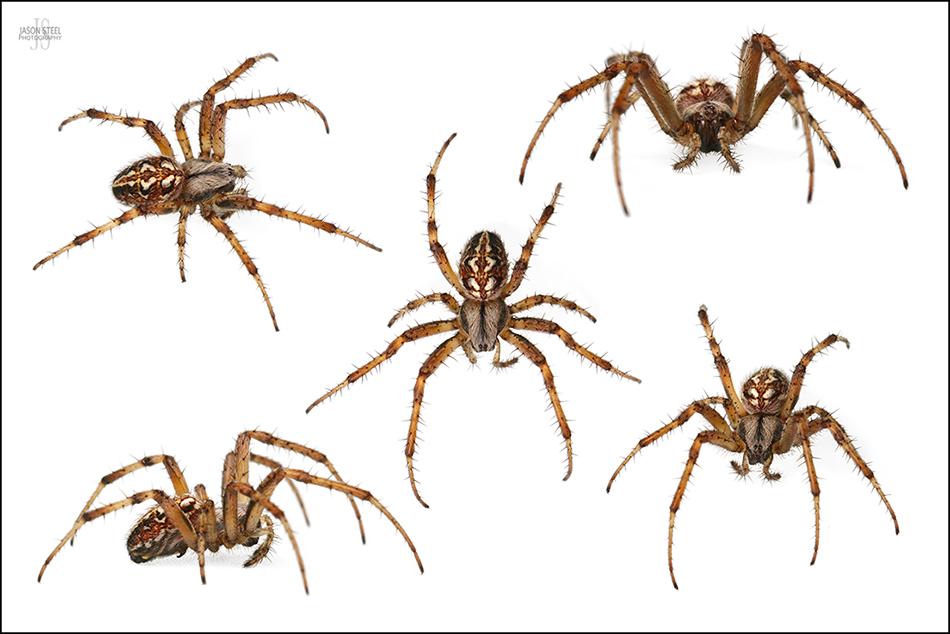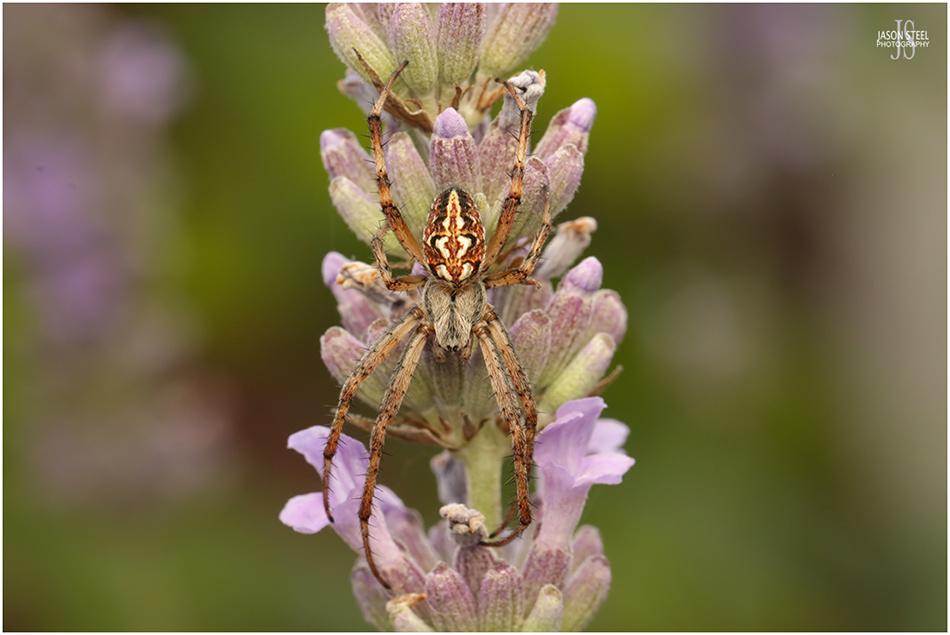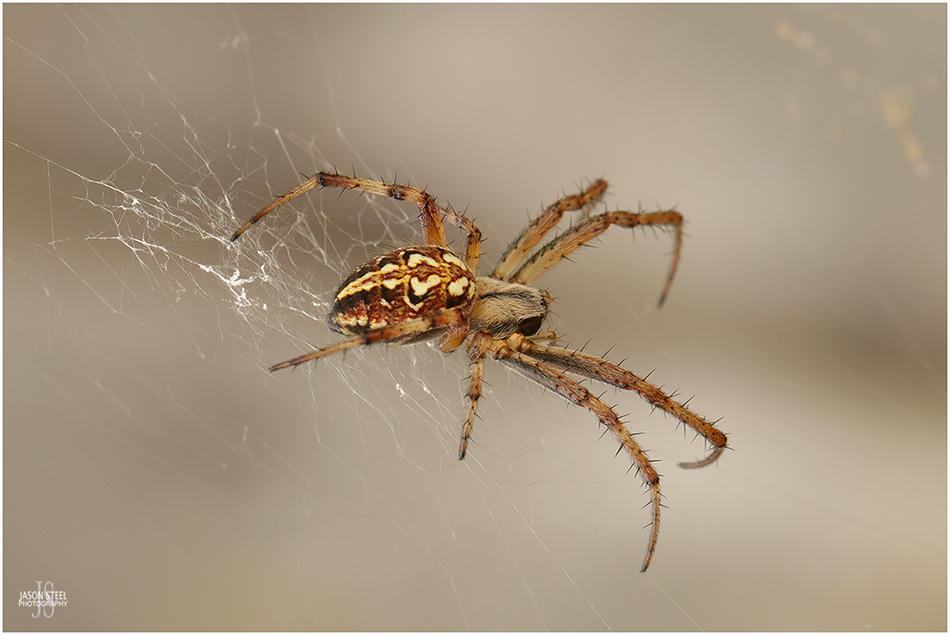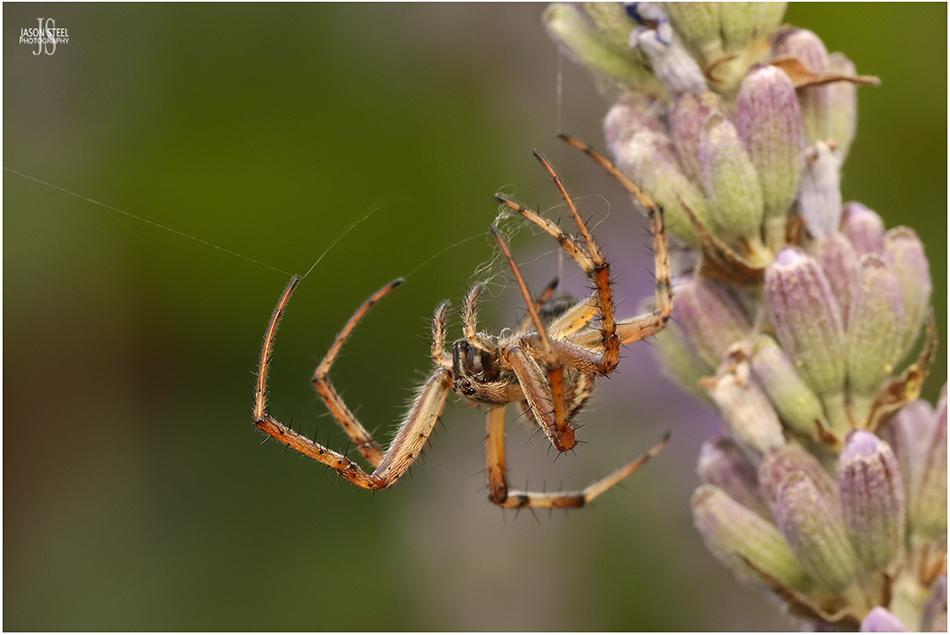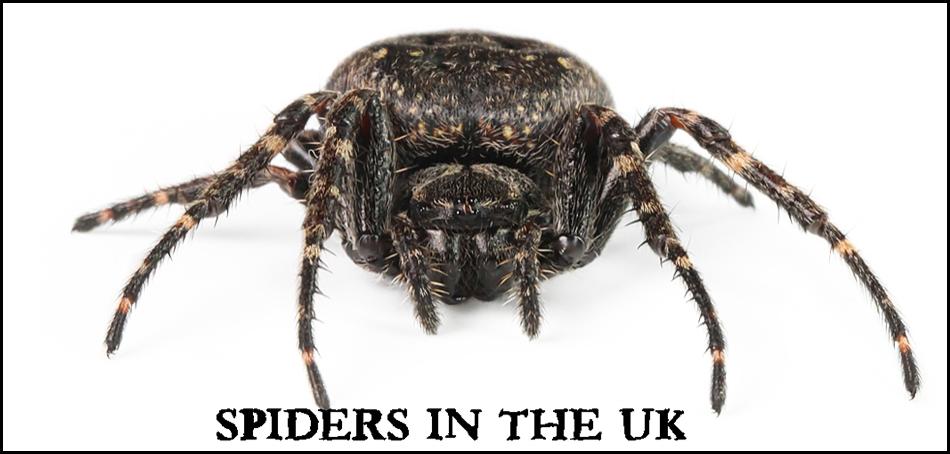
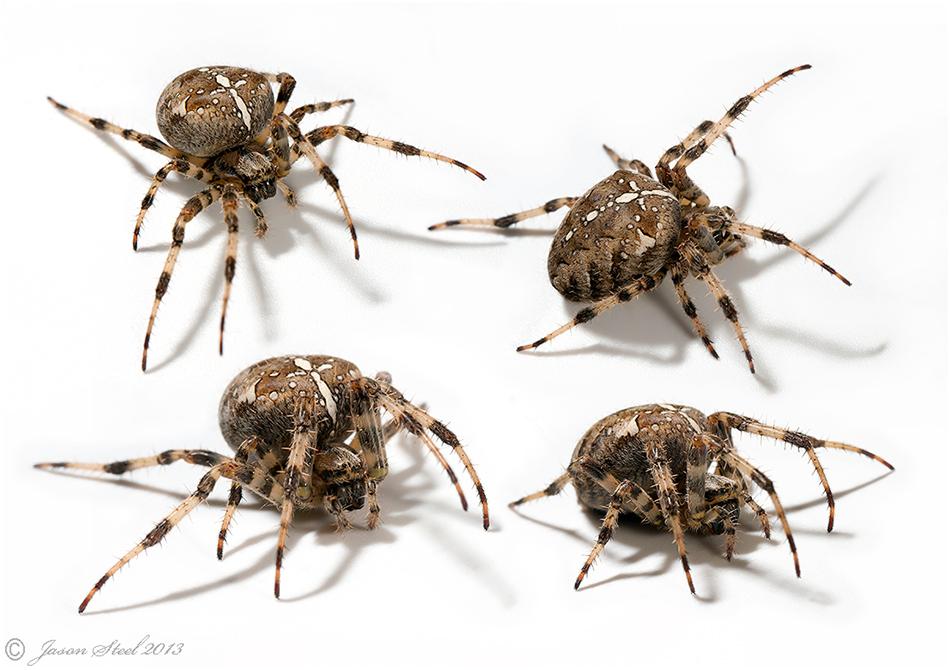
Gravid adult female Garden Spider - Araneus diadematus
Garden Spider / Cross Spider (Araneus diadematus)
The Garden Spider is one of the largest bodied spiders in the UK, especially in Autumn when the females are gravid. Garden Spiders are common across much of Europe as well as in parts of North America. Most specimens have a white cross on their abdomen but markings fade or disappear completely as the abdomen of gravid females stretches. The adults can come in a huge range of colours from yellow - brown - red - dark grey but the spiderlings are always bright yellow with a black triangle on the abdomen. Adult females can grow to a large body length of 20mm whilst males are slimmer and only reach 13mm. Their highly geometrical orb-webs are often around 200 - 400mm in diameter and the adult spider can be found either in the centre of the web or hidden close by on the other end of a trigger line from the web. The orb-webs are typically built and repaired after dusk. Other common names for this species include the European Garden Spider, Common Garden Spider, Crowned Orb-Weaver and the Pumpkin Spider.
British Arachnological Society Factsheet
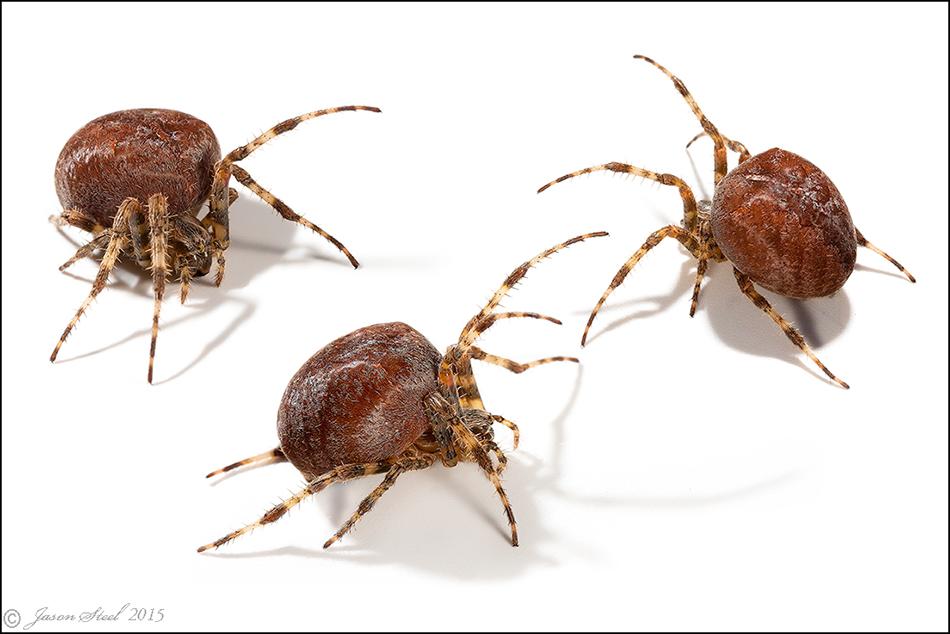
Heavily gravid adult female Garden Spider, found in an urban residential garden 8th July 2015
With heavily gravid female Garden Spiders the identifiable cross markings can be almost absent, as in the photo above. At this stage they can be confused with the similar Four Spotted Orb-Weaver Spider, Araneus quadratus. However, the abdomen of the Araneus quadratus is rounder in shape and even when the abdomen of Araneus diadematus is this stretched you can still make out the slight corners at the top, which are not found on Araneus quadratus.
With a body length of 20mm this example pictured above is one of the largest I have seen, and looked ready to burst it was so heavily gravid with eggs. Sometimes the abdomen can be seen to start to rupture, with cracks / splits starting to appear.
As this spider was approached with my camera it repeatedly raised its front legs. When spiders raise their front legs in this manner, it can appear to be a defensive threat display. However, this is usually nothing more than an inquisitive and investigatory position. Many species of spider have sensory hairs on their legs that allow the spider to not only pick up on the slightest vibration, or movement of air, but it's believed these sensory hairs could also allow the spider to “taste the air”. The spider was simply trying to work out what me and my camera were, and whether evasive action was required to escape a potential threat.
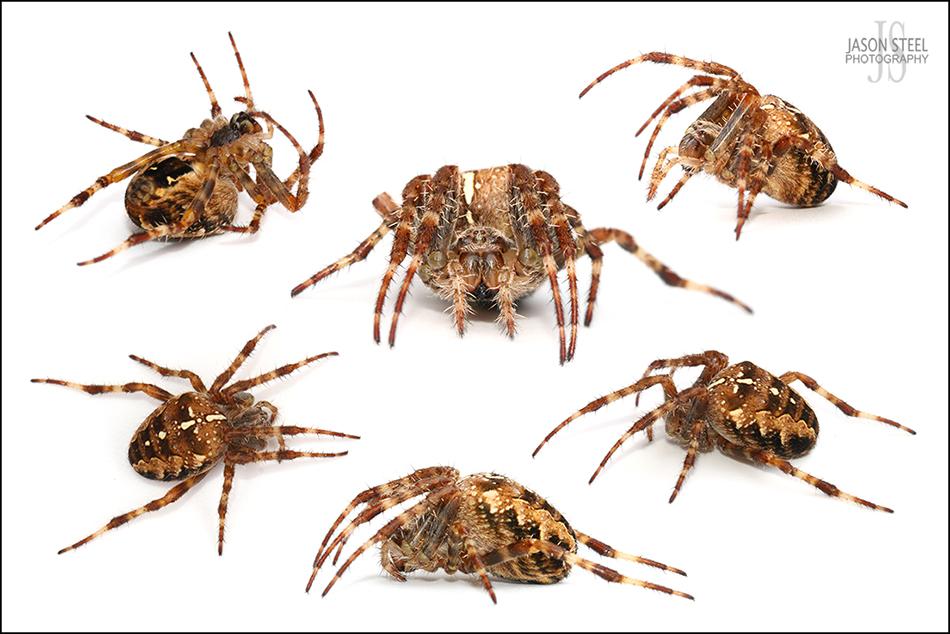
Adult female Garden Spider - Araneus diadematus
Garden Spiders are highly variable in both colour and shade and can be found in most habitats. Sightings are most common in late summer / autumn when the females are gravid and large in size.
Once ready to lay her egg-sac the large female leaves her web. Often she will eat the old web and recycle the silk proteins for use when she builds herself a silken retreat to lay her egg-sac in. The adult female will stay close by the egg-sac to initially stand guard but will usually die once the first winter frosts arrive. The spiderlings usually disperse in the spring once the temperatures start to rise.
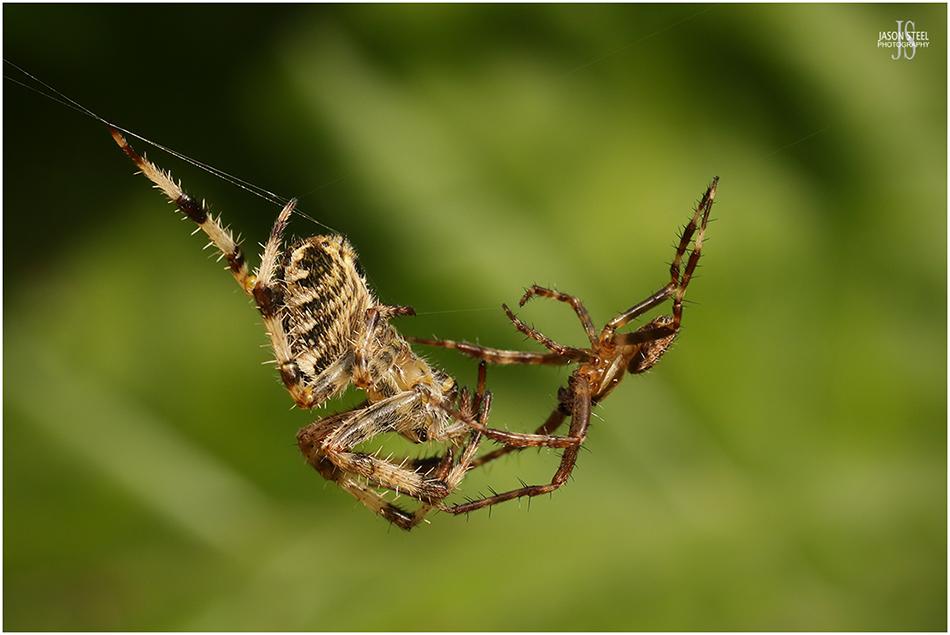
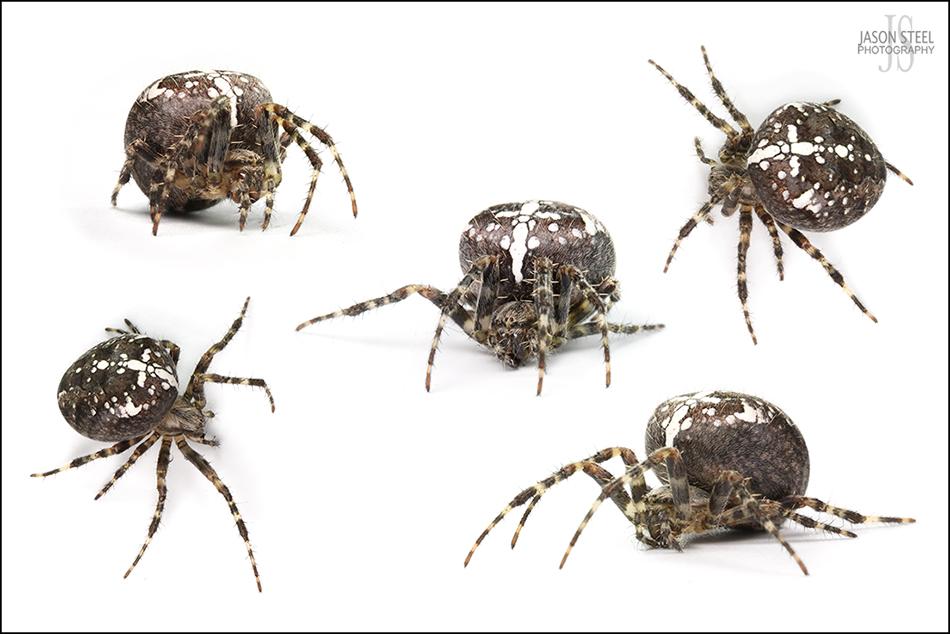
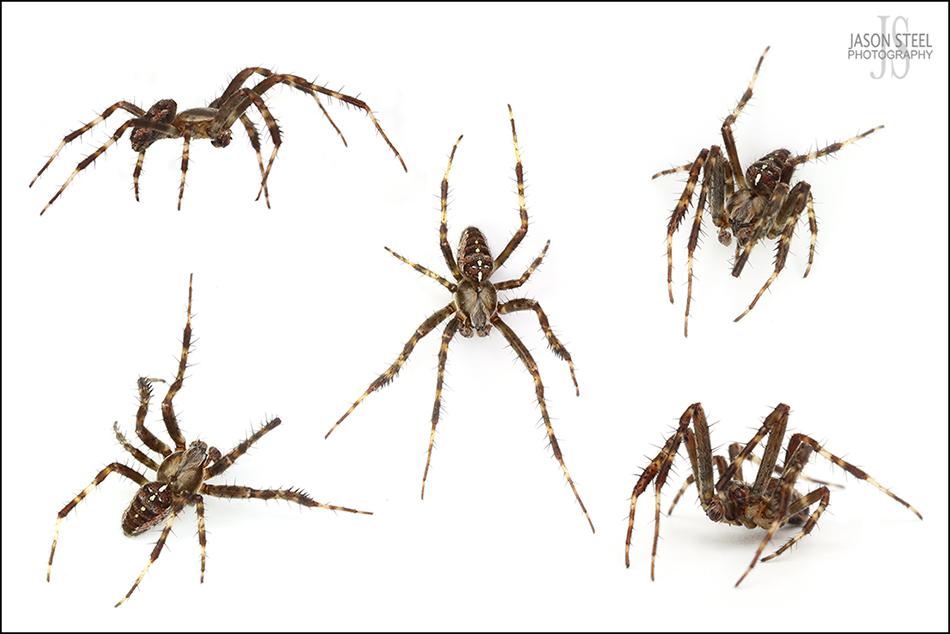
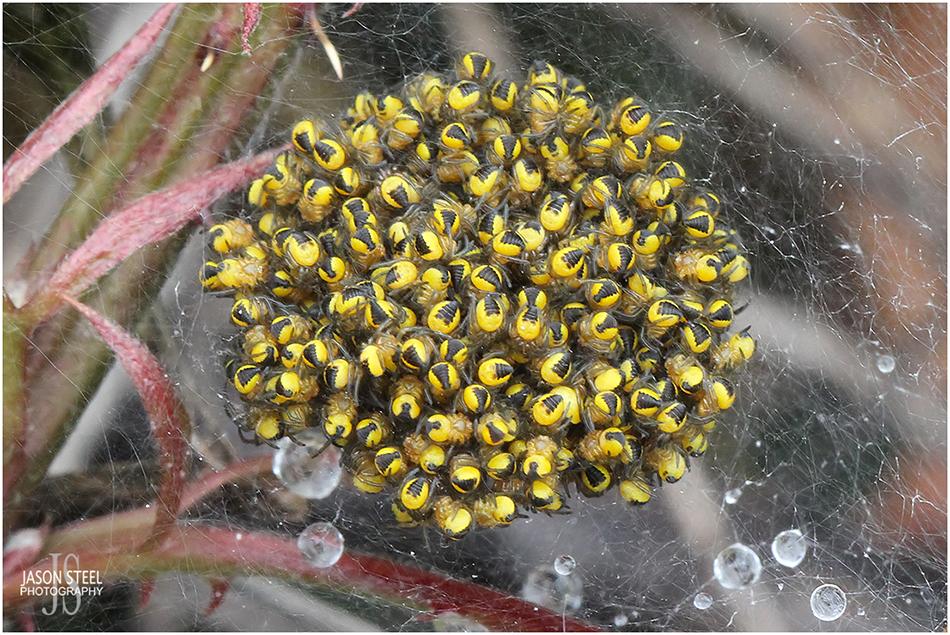
Araneus diadematus - spiderlings
When the tiny spiderlings hatch they will remain huddled together as a cluster ball for a day or two, after which they will disperse. As soon as they disperse the spiderlings will quickly begin building tiny orb-shaped webs. The spiderlings are bright yellow with pyramid markings on the rear of their abdomens. These markings are common amongst many different Orb-Weaver Spiders though so positive identification may not be possible at this stage.
Spiderlings of the Garden Spider, Araneus diadematus, can look very similar to those of the closely related Four Spotted Orb-Weaver Spider, Araneus quadratus. However Araneus diadematus is a brighter and more vibrant yellow, with dark, bold abdominal markings. The spiderlings of Araneus quadratus are a paler yellow with less distinct and more pale brown abdominal markings.
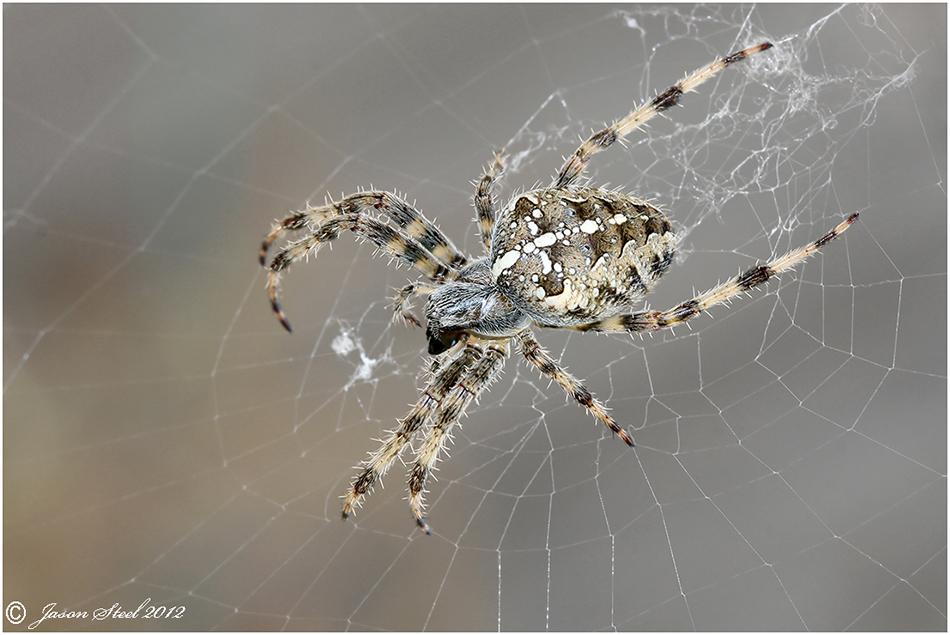
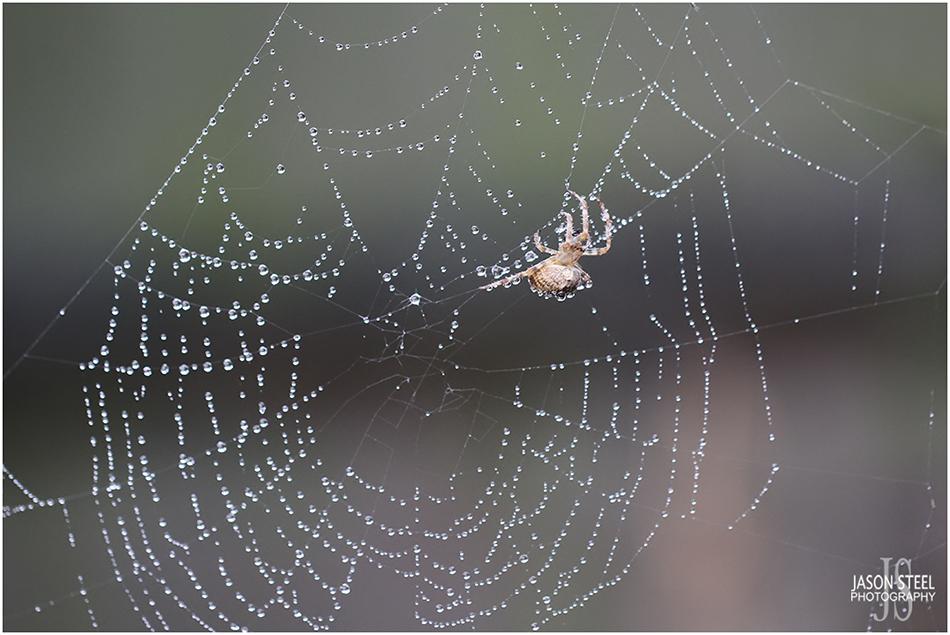
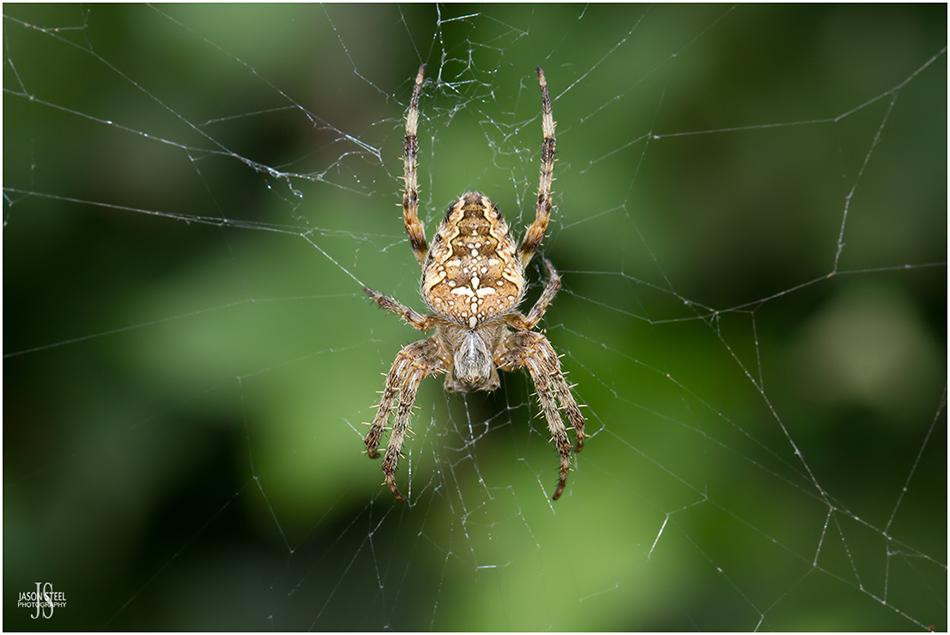
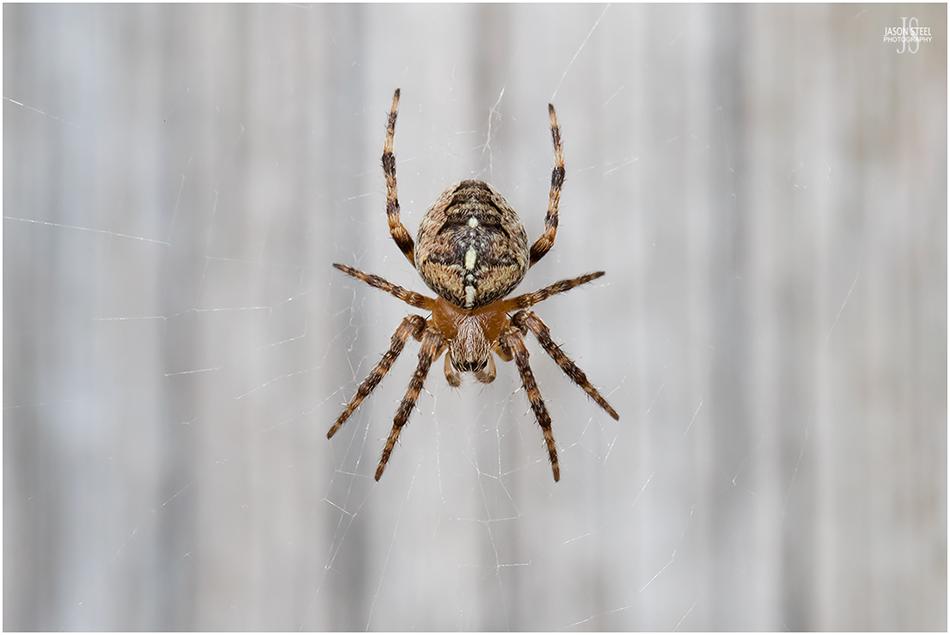
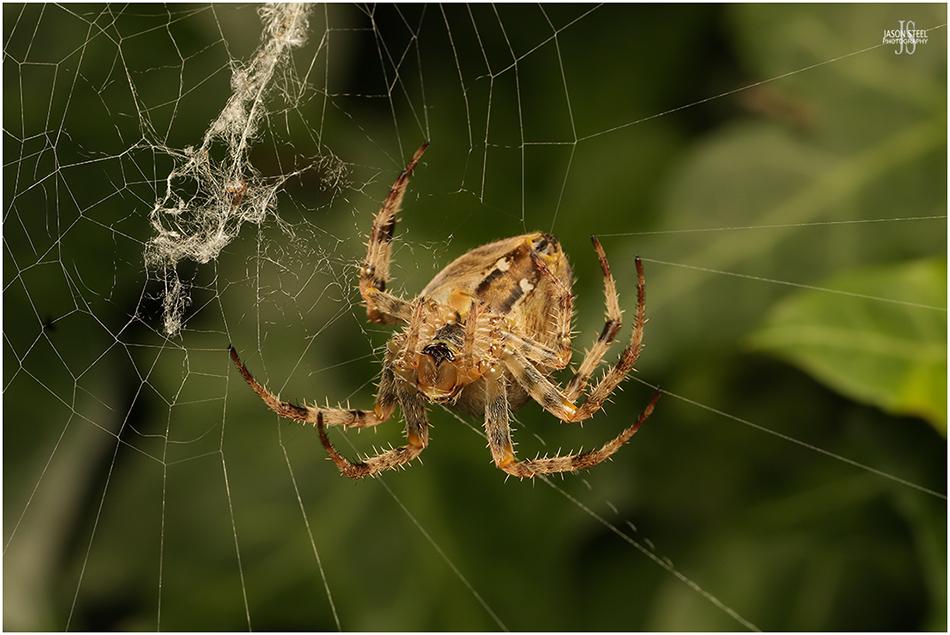
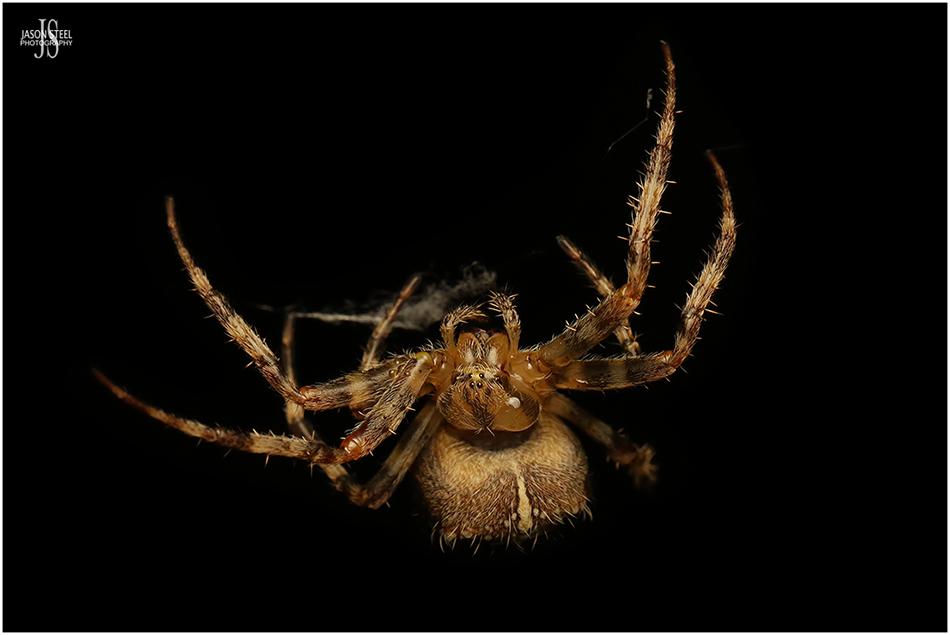
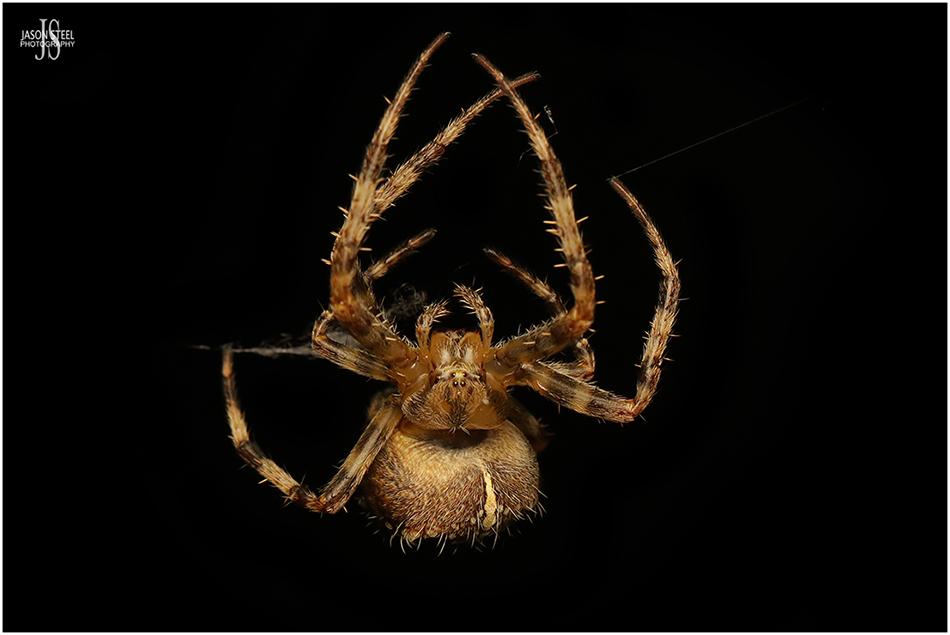
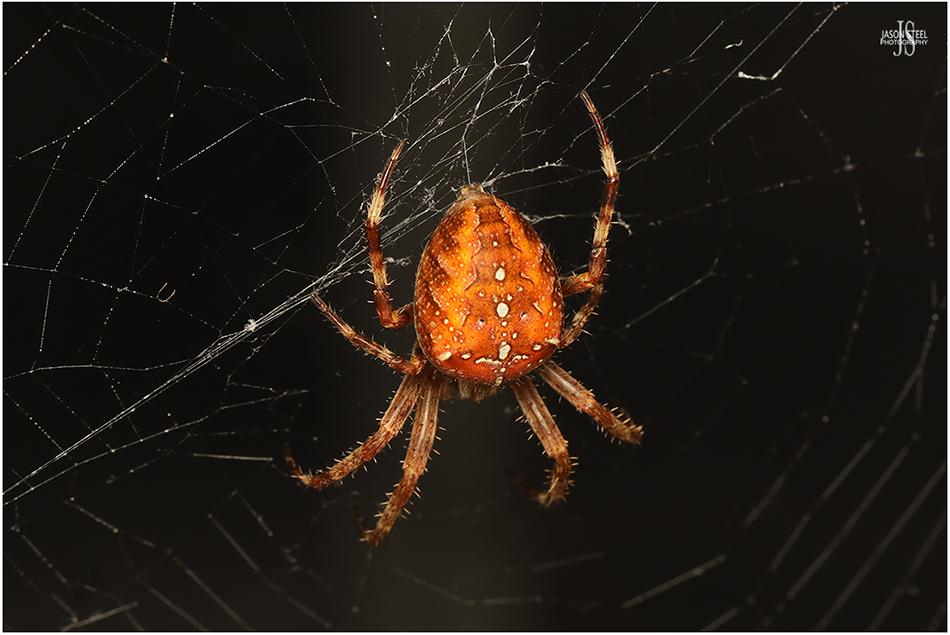
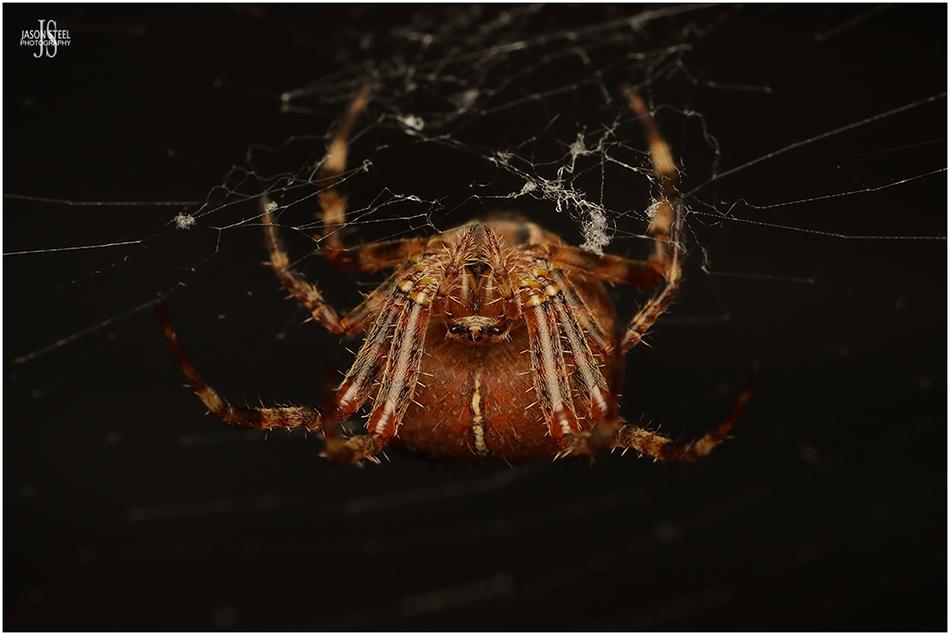
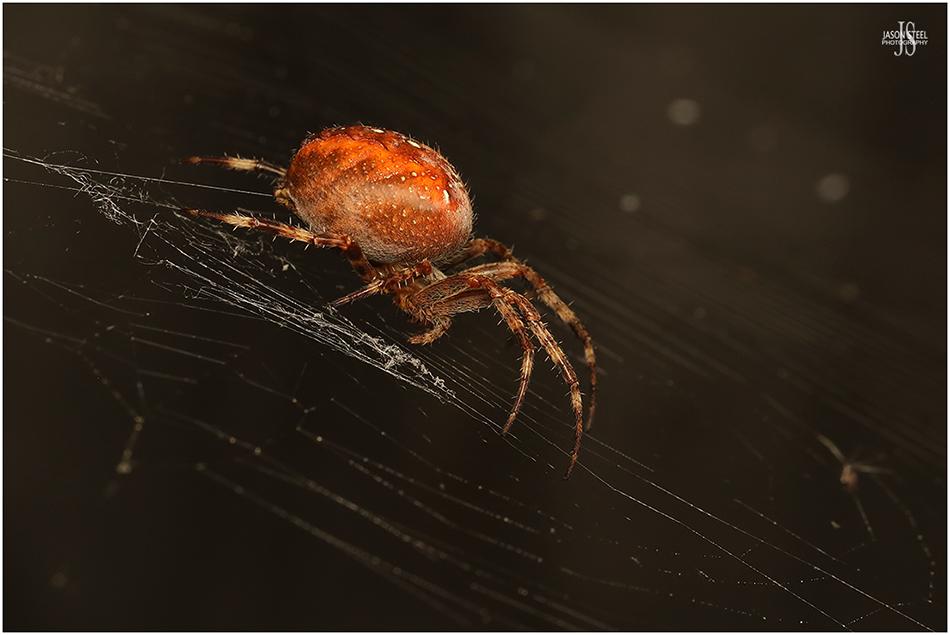
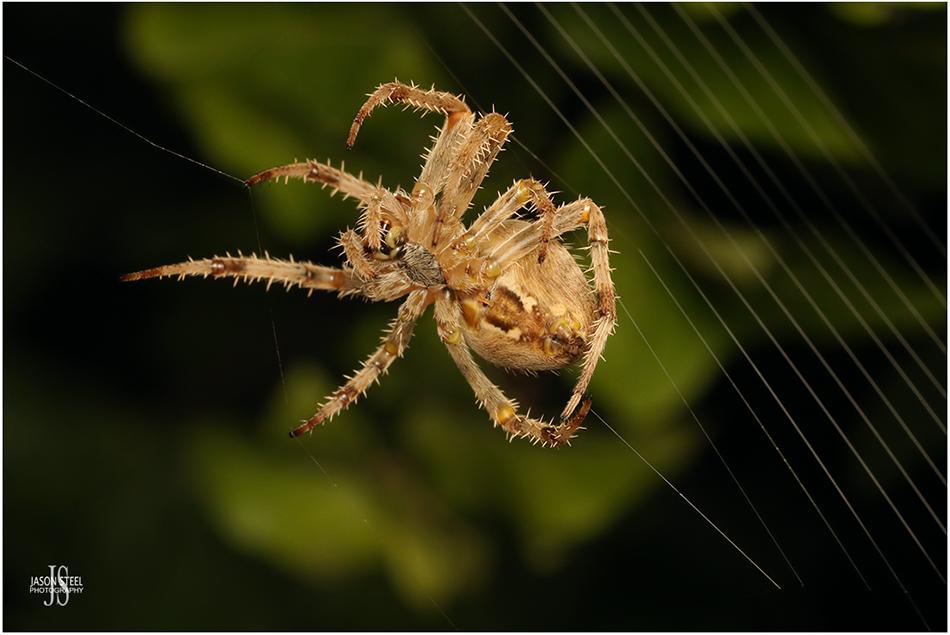
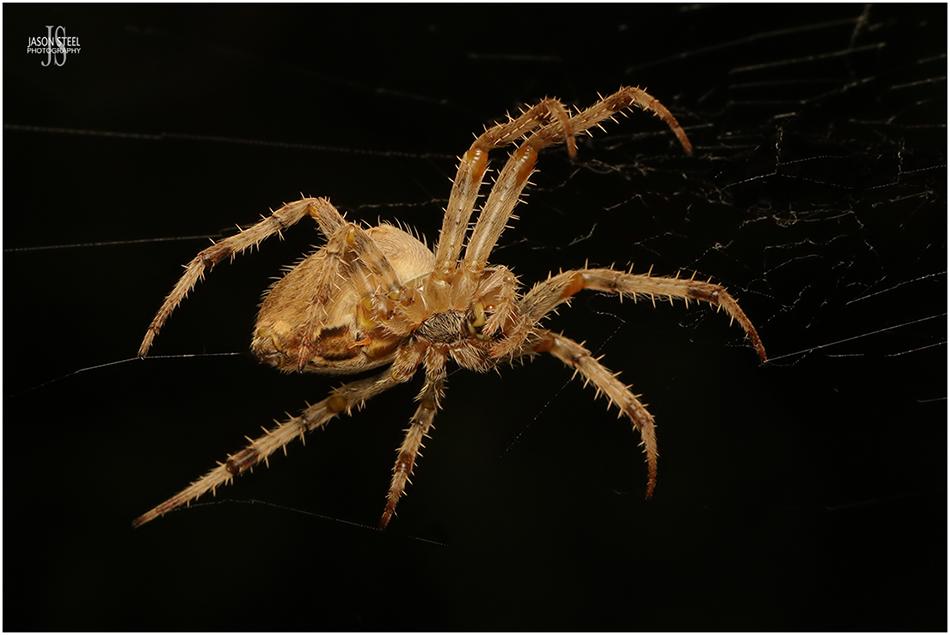
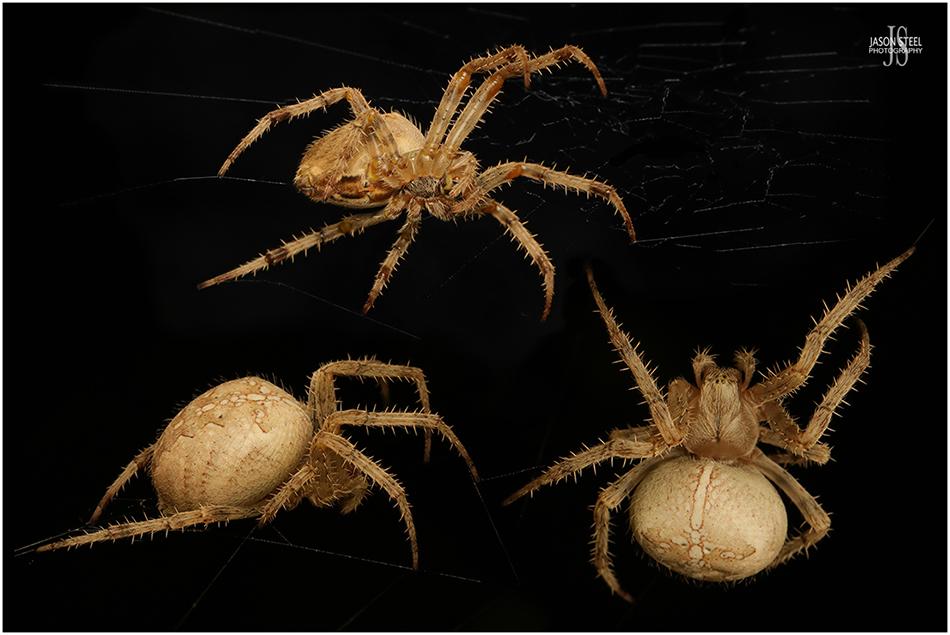
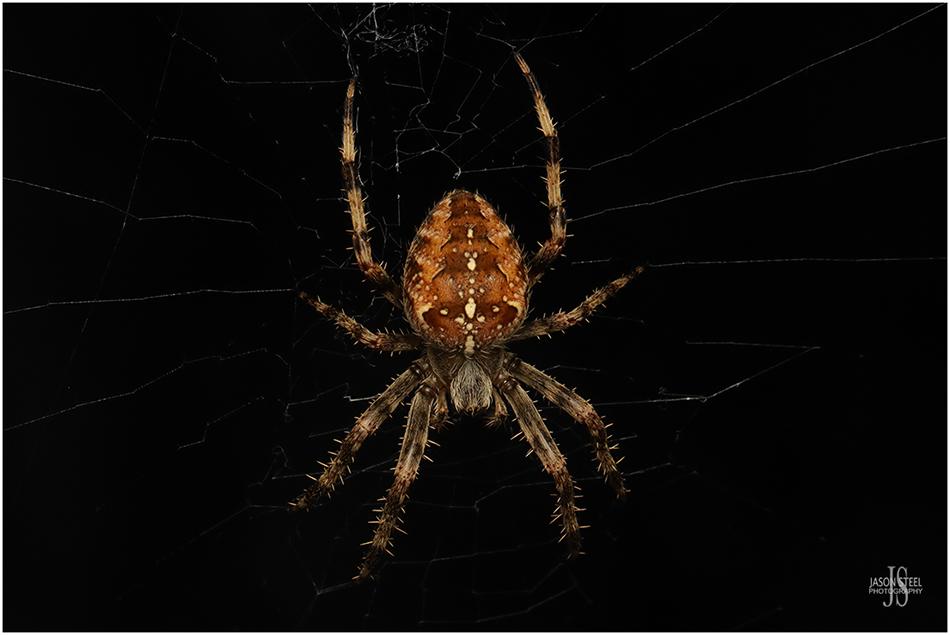
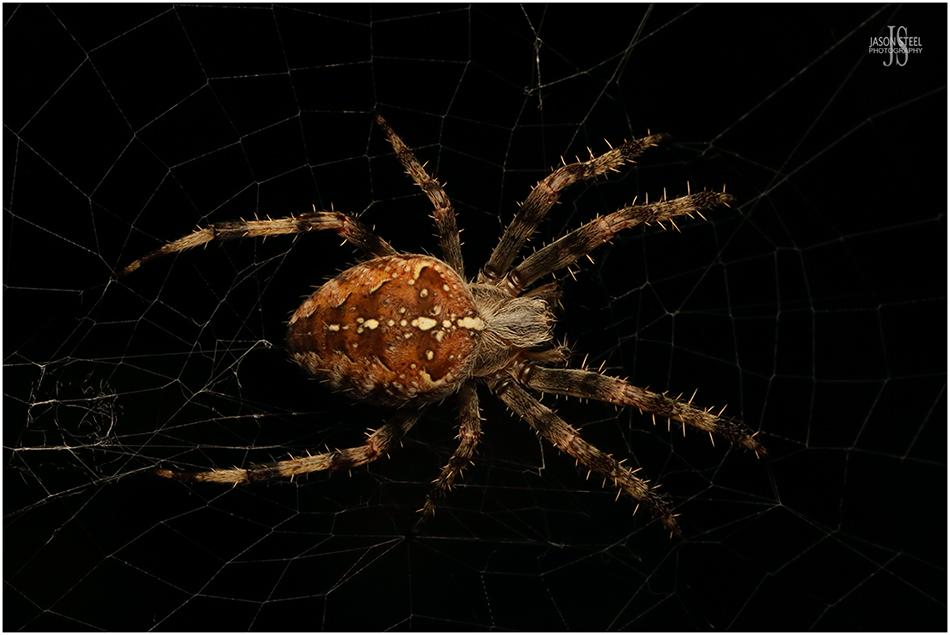
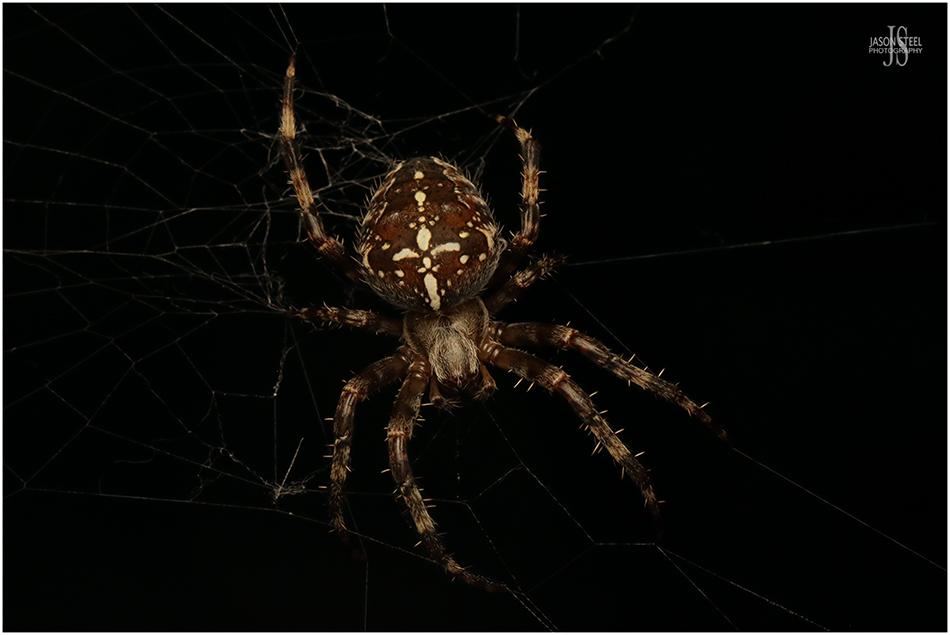
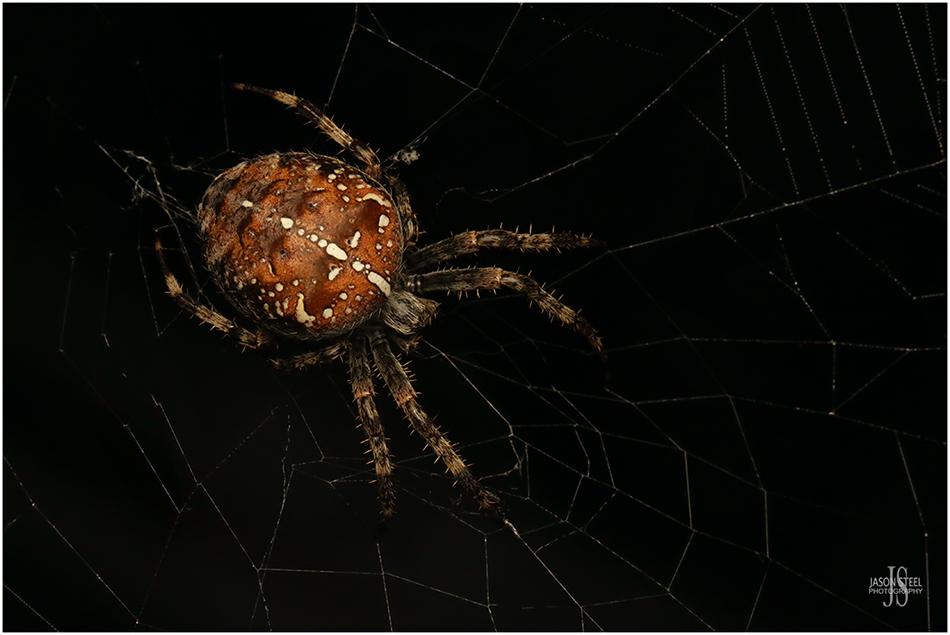
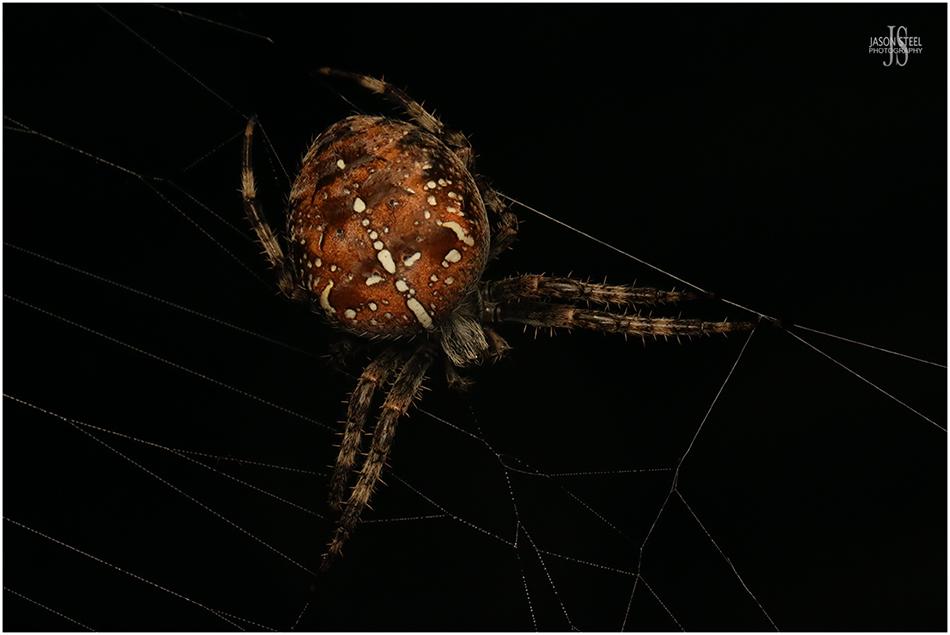
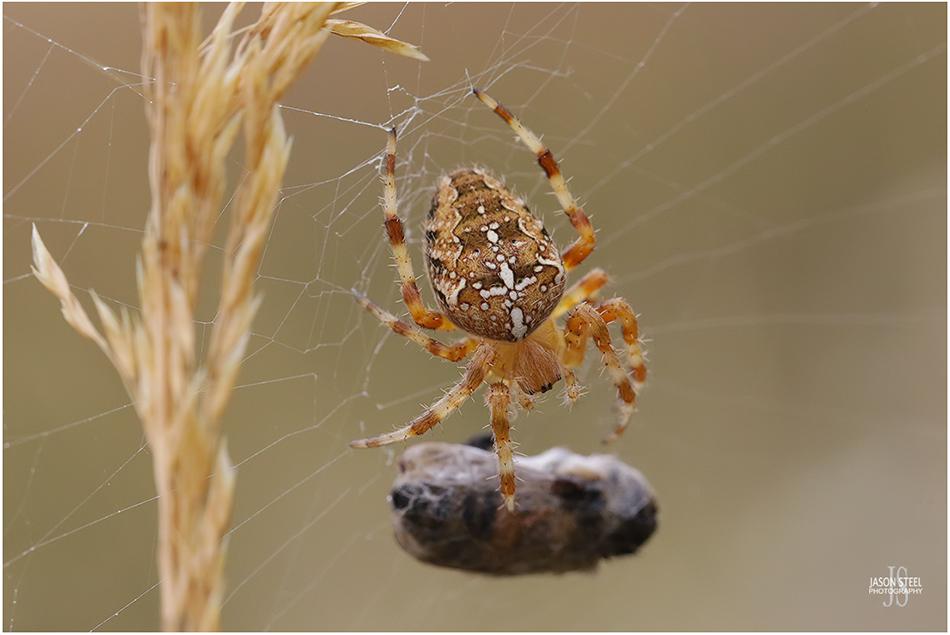
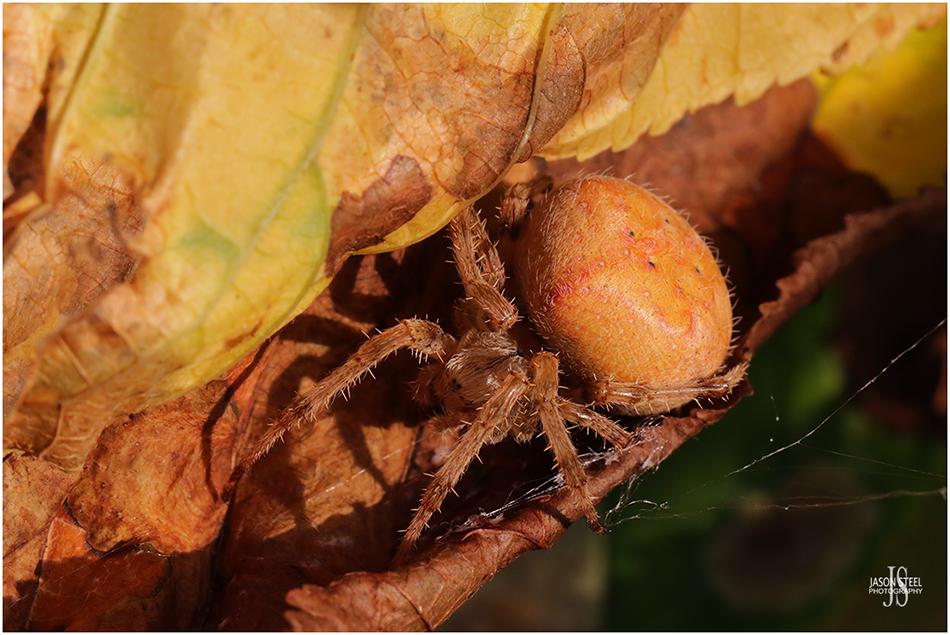
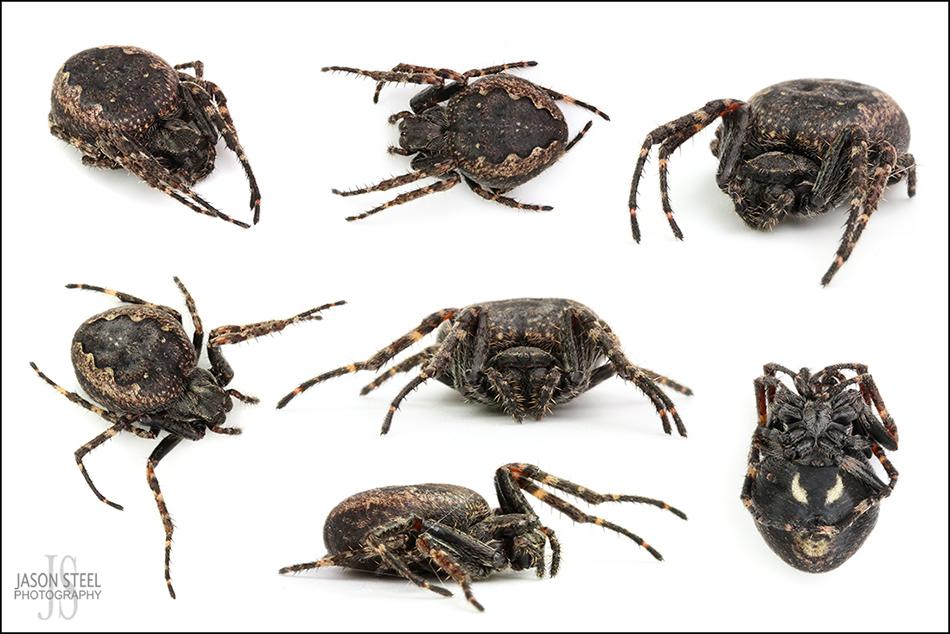
Large 15mm Female Walnut Orb-Weaver Spider - Nuctenea umbratica
Walnut Orb-Weaver Spider - (Nuctenea umbratica)
Also known as Toad Spider or Evening Spider, they are found across England, becoming more scarce further north. Females have a body length growing to 15mm and males just 11mm. The flat dark brown abdomen and zig-zag edges are identifying features of this nocturnal spider. Females are common from the spring onwards but they can be seen all year round and even endure temperatures as low as -19 degrees Celcius! Males are usually only found in the summer. During the day these spiders hide in out-buildings, fences, rock crevices or loose tree bark, only coming out in the day to secure prey caught in their web. During the evening they often sit in the middle of their web. Walnut Orb-Weavers have been known to bite humans when roughly handled, resulting in itchiness and burning sensations to the bite area, sometimes followed by a red patch with white lumps. The two yellow or cream crescent moon shapes on the underside of the abdomen are key identifying features of this species. Unlike the Garden Spider (Araneus diadematus) that only lives for one season, the Walnut Orb-Weaver (Nuctenea umbratica) can live for 2-3 years. The large female pictured above lived on my garden fence for three years.
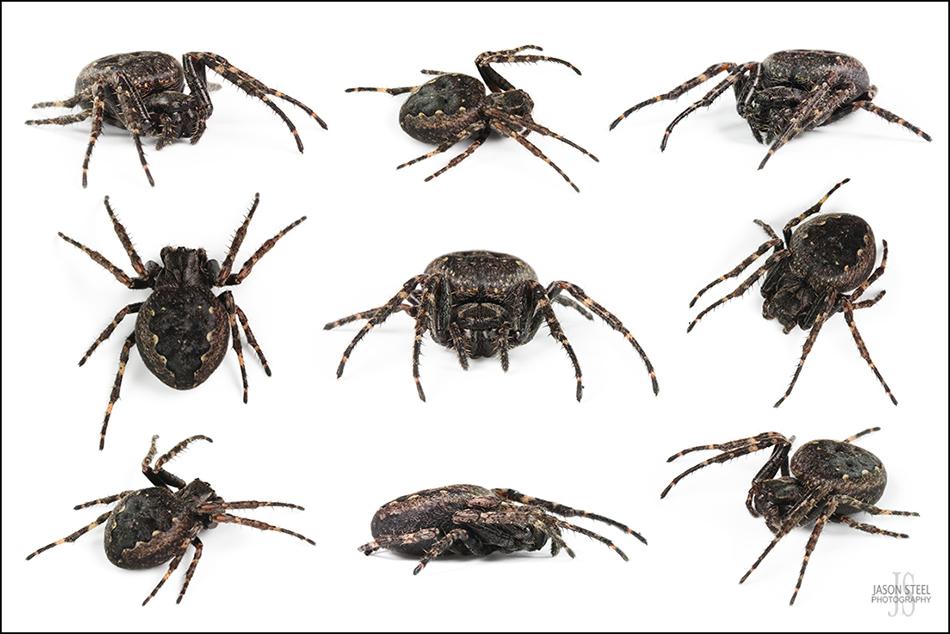
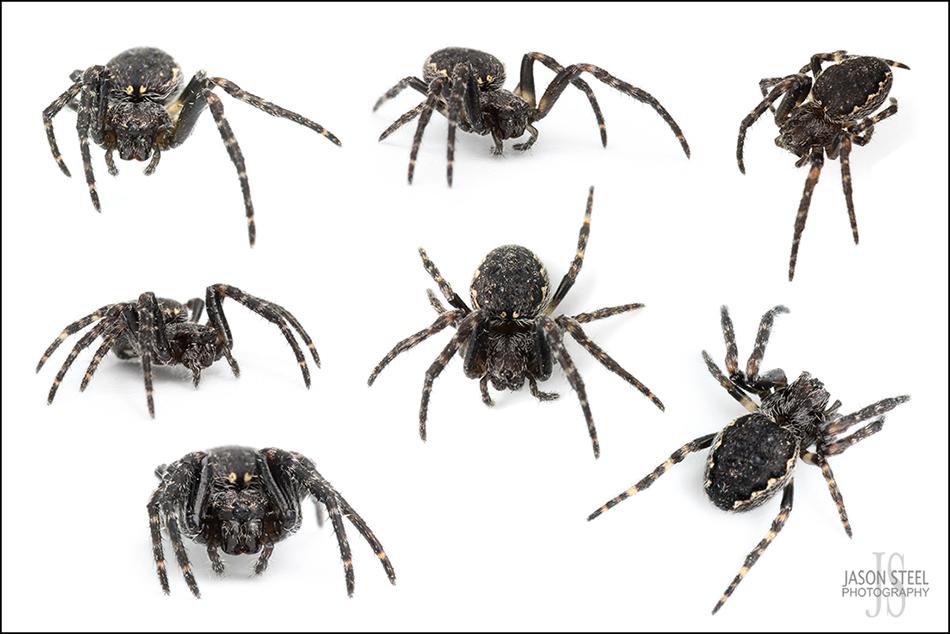
4mm Juvenile Walnut Orb-Weaver Spider - Nuctenea umbratica
Both male and female Walnut Orb-Weavers have a dark brown leaf-shaped mark on the upperside of their abdomen. On the underside they both have two cream coloured teardrop shaped markings.
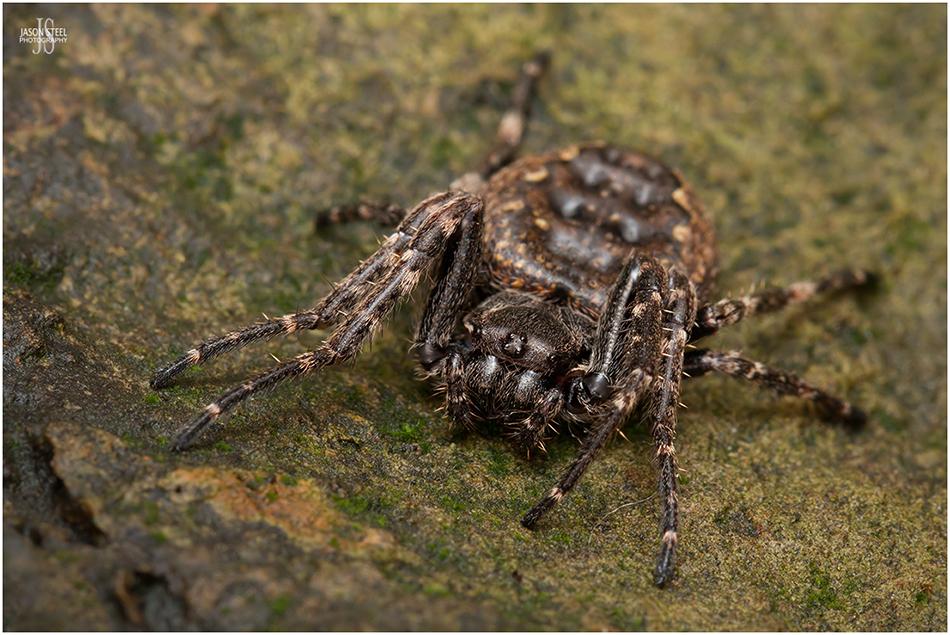
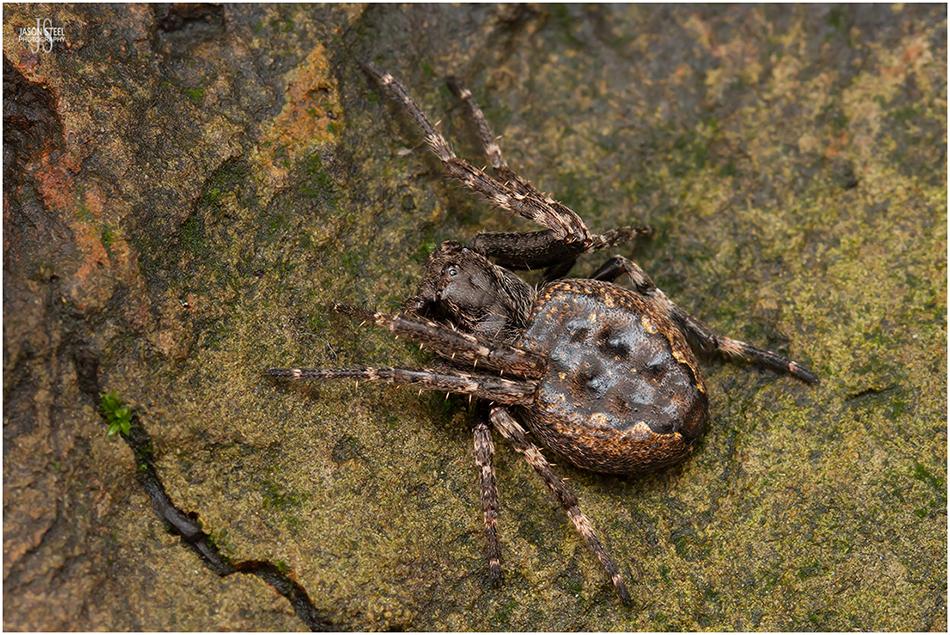
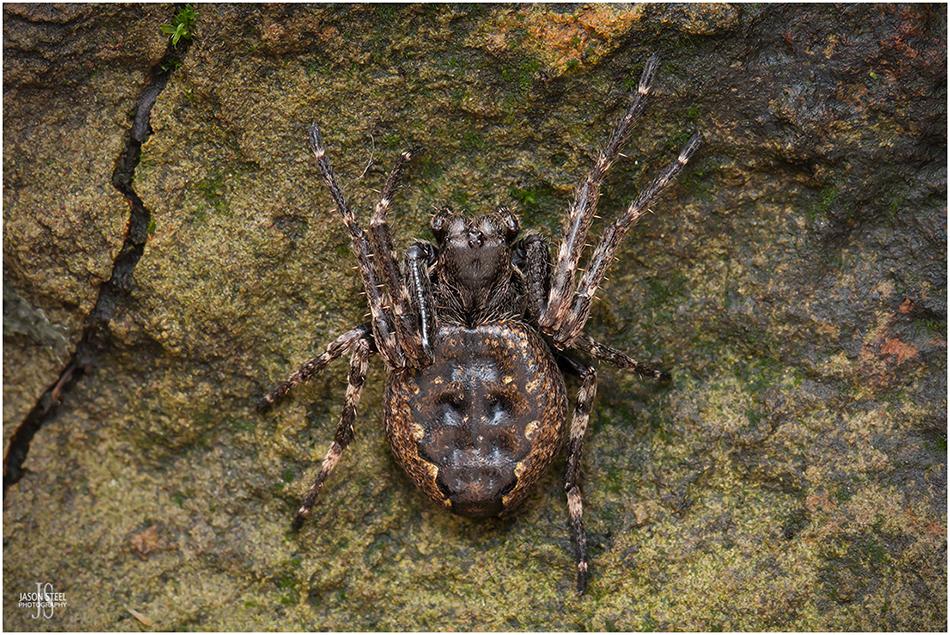
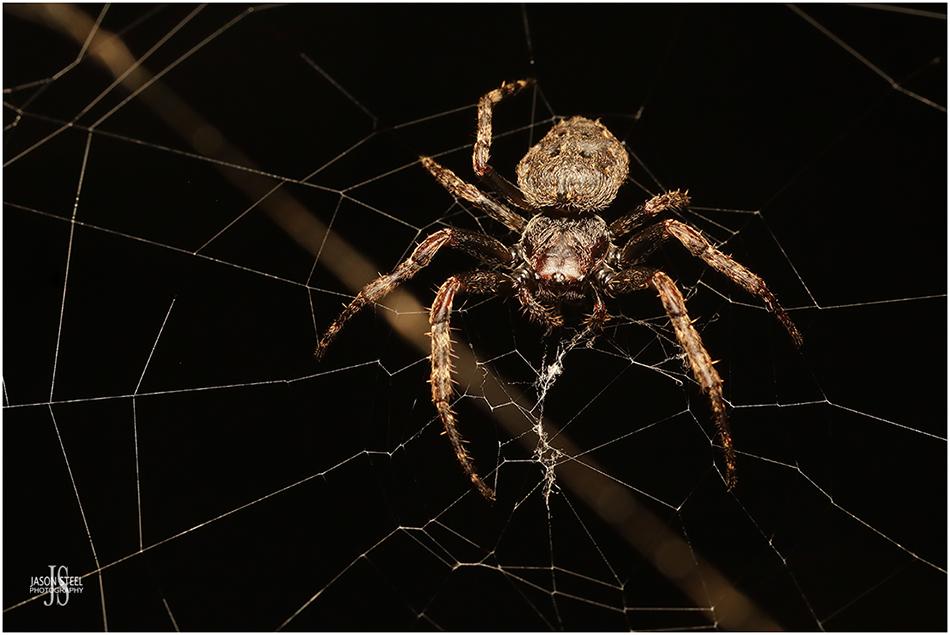
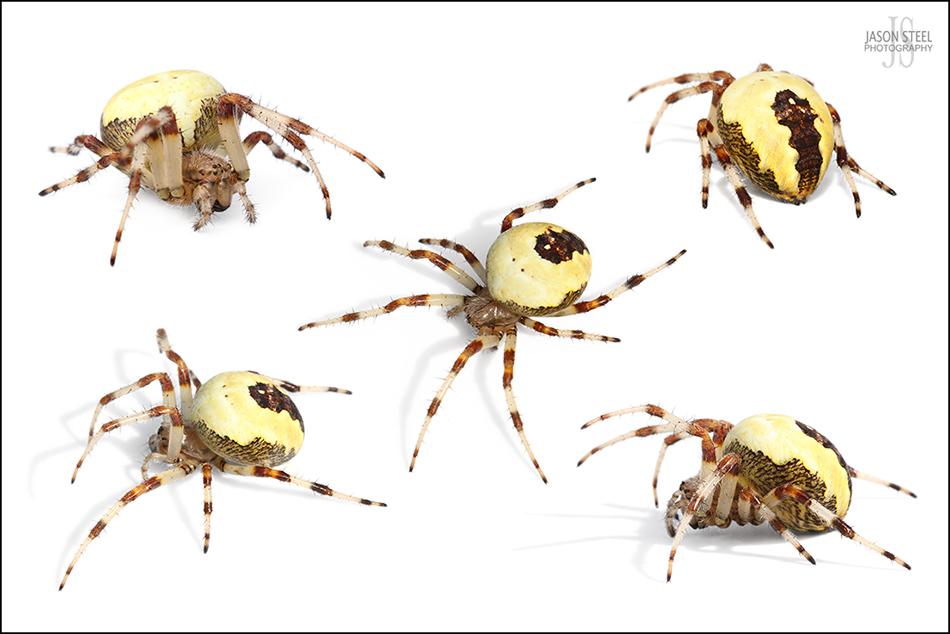
Adult female Marbled Orb-Weaver (Araneus marmoreus var. pyramidatus)
Marbled Orb-Weaver (Araneus marmoreus)
The Marbled Orb-Weaver is another of our larger native orb-weaving spiders. These spiders are commonly associated with damp heathland and woodland edges, and are often found on waterside vegetation. Females have a maximum body-length of 14mm with a 35mm leg-span. Males have a maximum body-length of 9mm with a 18mm leg-span. Adults specimens can be seen in late summer and autumn. There are two variations of this species. One has a completely marbled abdomen which can vary in colour, but is regularly seen in orange. The other (Araneus marmoreus var. pyramidatus) has a pale yellow abdomen with a dark black or brown patch at the back. The Marbled Orb-Weaver is more common in the south of England whilst the Araneus marmoreus var. pyramidatus variation is usually found around Norfolk to Yorkshire on the East of England.
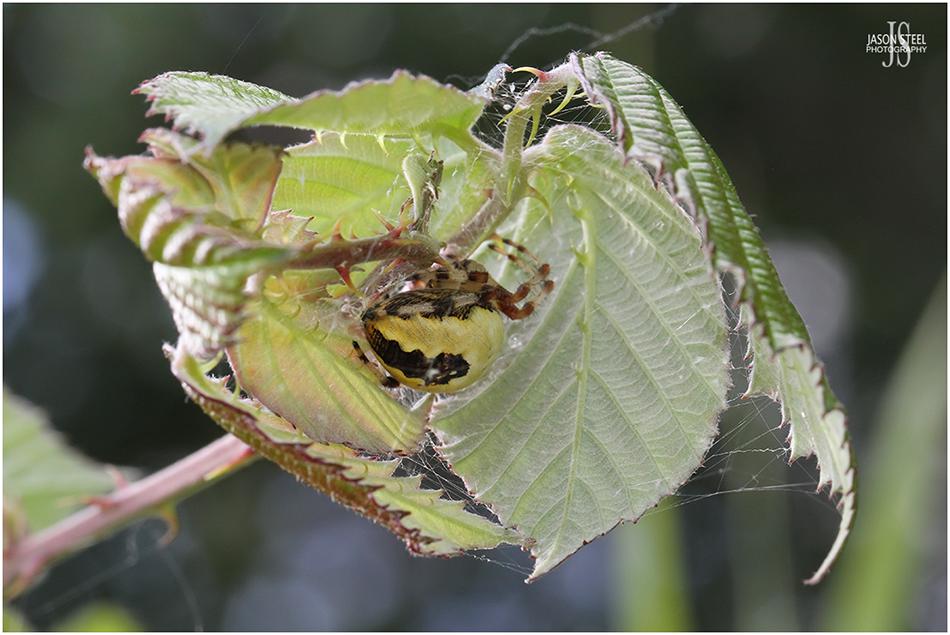
Marbled Orb-Weaver (Araneus marmoreus var. pyramidatus) found at Horsey, Great Yarmouth, 4th September 2019.
Like most orb-weaver spiders the Marbled Orb-Weaver builds a retreat near one corner of its web where it will hide away for most of the day, coming out at night to repair and maintain its web.
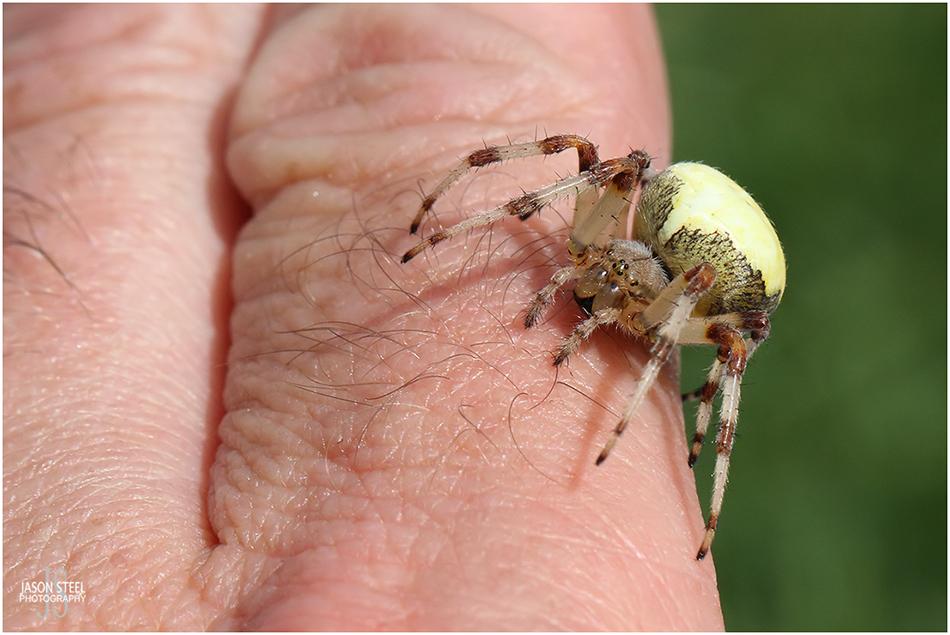
Marbled Orb-Weaver walking over my hand
A spider of this size would have no problem piercing human skin with its fangs. But like all spiders it has no interest in biting humans, it just wants to get away.
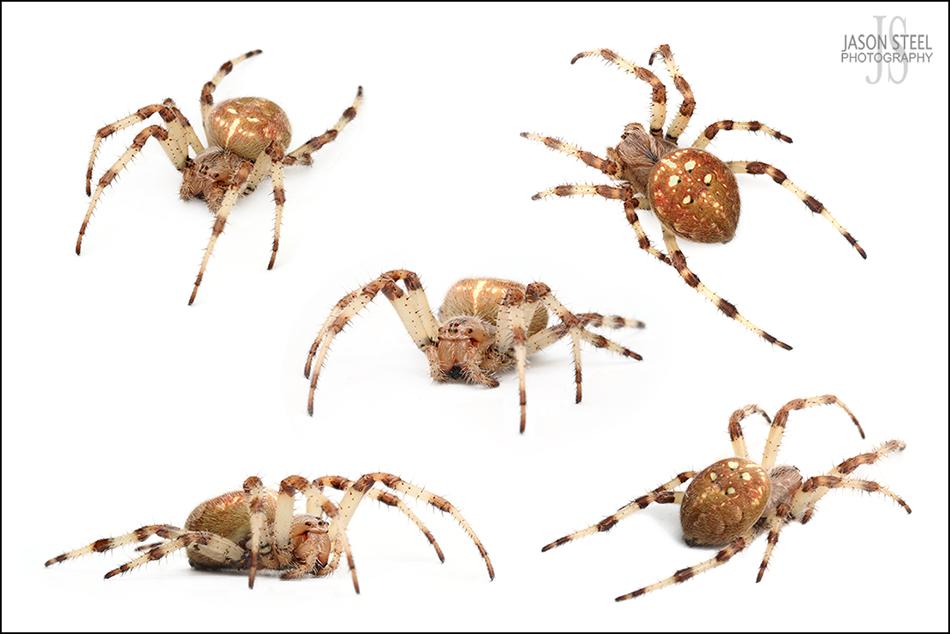
Large adult female Four Spotted Orb-Weaver Spider - Araneus quadratus
Four Spotted Orb-Weaver Spider - (Araneus quadratus)
The Four Spotted Orb-Weaver is recorded as being Britain's heaviest spider with some specimens weighing over 2.5 grams. Females have a body length of up to 20mm and a leg-span in excess of 35mm. Males are around half that size. Adults can be found during late summer and autumn. These spiders usually build large orb-webs situated between substantial vegetation. The distinguishing four spots on the abdomen can be feint in males and difficult to see in heavily gravid females with stretched bodies. The colour of this species can vary enormously from red, brown, cream or green. The abdominal markings can be very bold or hardly visible. The orb-webs are often built in close proximity to those of the Garden Spider, Araneus diadematus, to which it is closely related. Araneus quadratus is less commonly associated with residential gardens though and is more common in undisturbed, rural areas.
According to the British arachnologist, William Bristowe, one Araneus quadratus specimen was documented to slowly change colour when taken into captivity and kept in a cardboard box. This isn't a species usually associated with this ability so it's definitely something that needs further investigating.
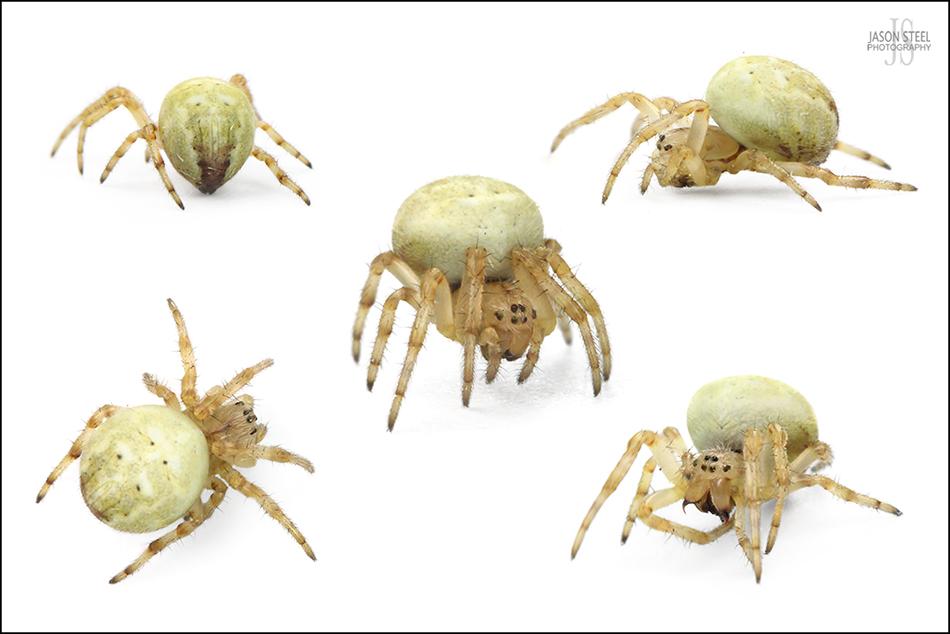
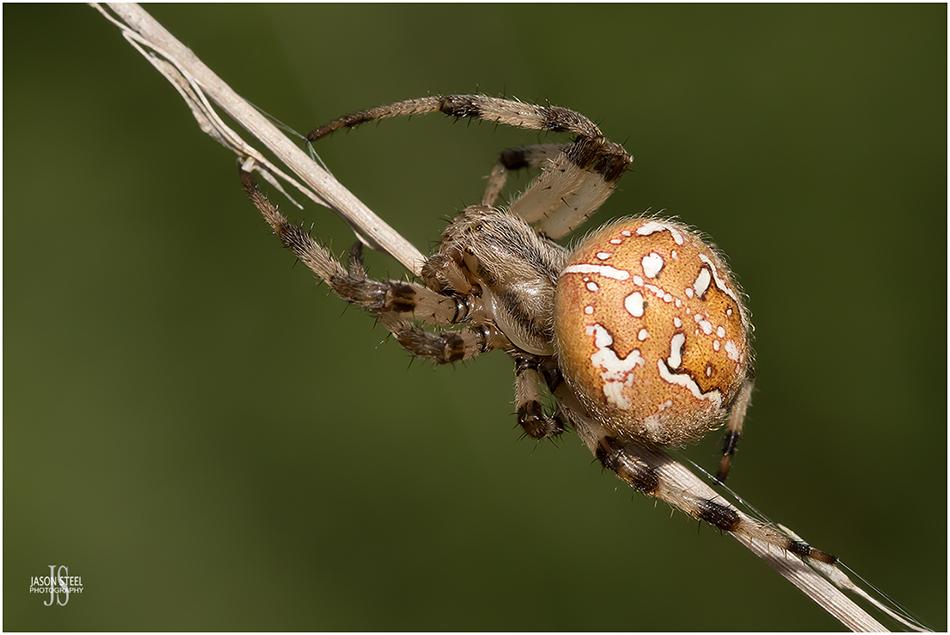
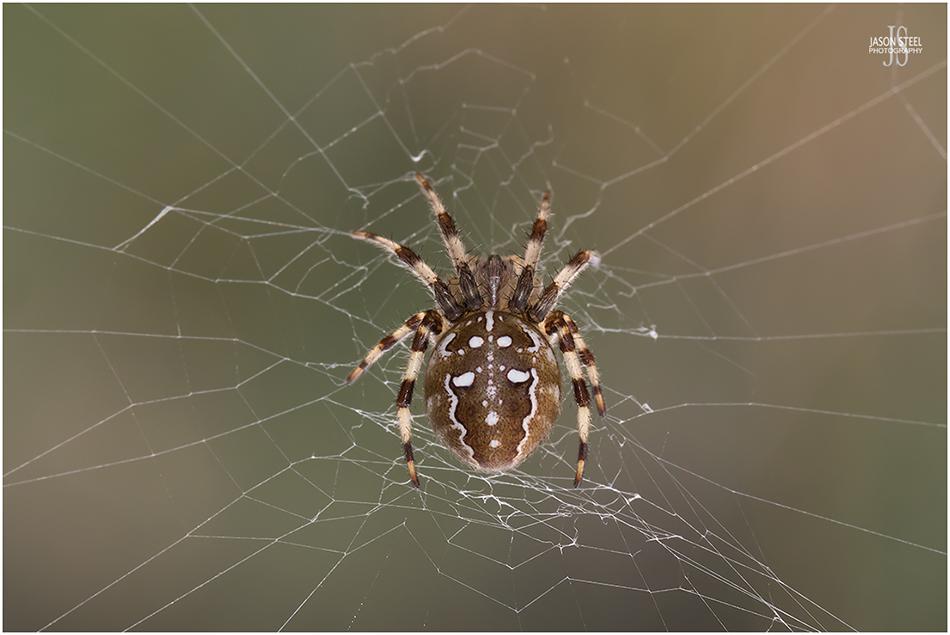
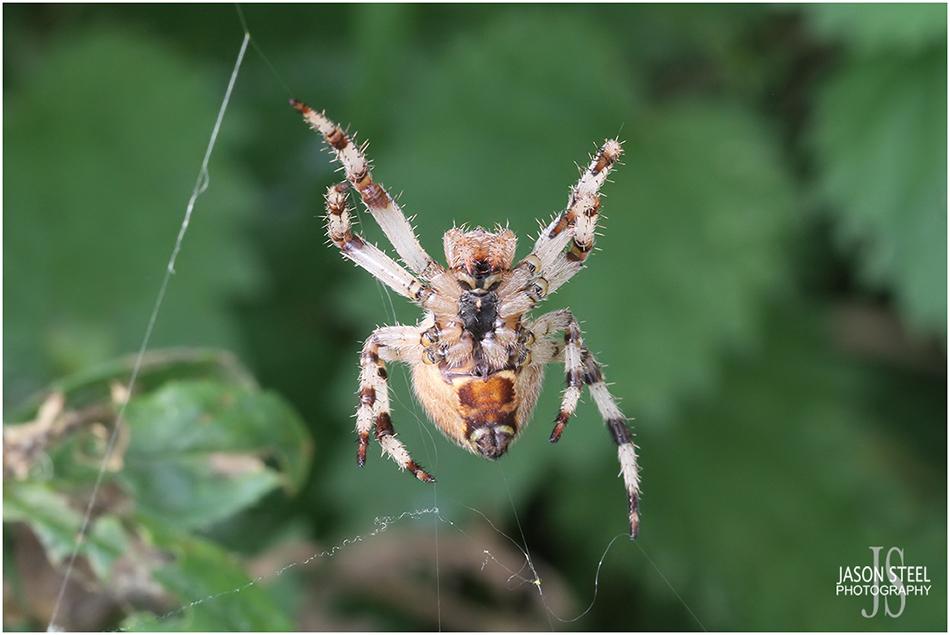
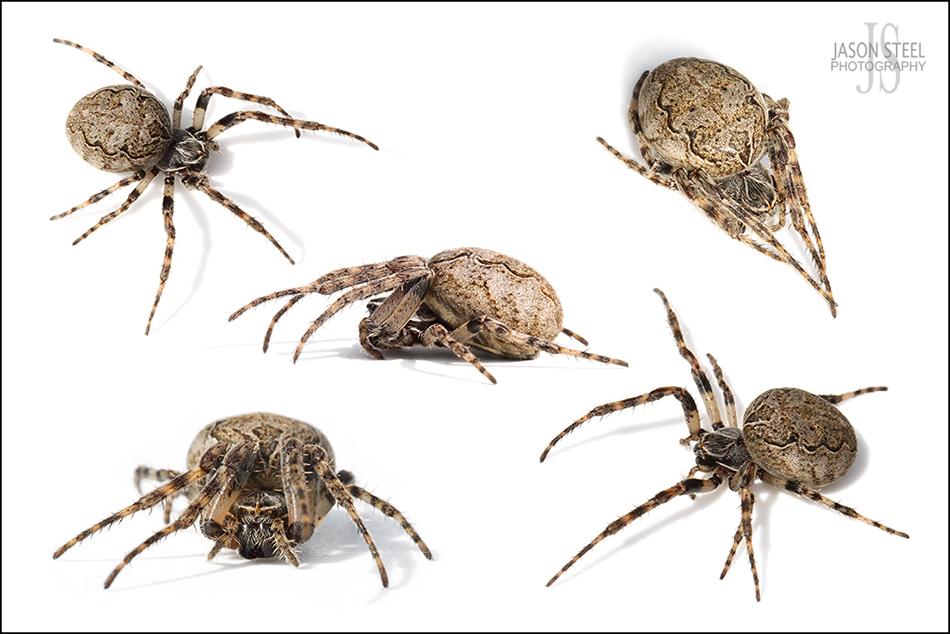
Adult female Bridge Orb-Weaver Spider - Larinioides sclopetarius
Bridge Orb-Weaver Spider - Larinioides sclopetarius
The Bridge Orb Weaver gets its name from its tendency to dwell in / on man made structures near water, such as bridges, fences and bird hides. This species is also seen on tree trunks but is seldom found on vegetation. They are on occasion also referred to as the Gray Cross Spider. The Bridge Orb Weaver is the largest of the Larinioides with the females having a body length of up to 15mm, as with the specimen pictured above. Adults are usually seen between May - October and females are known to overwinter.
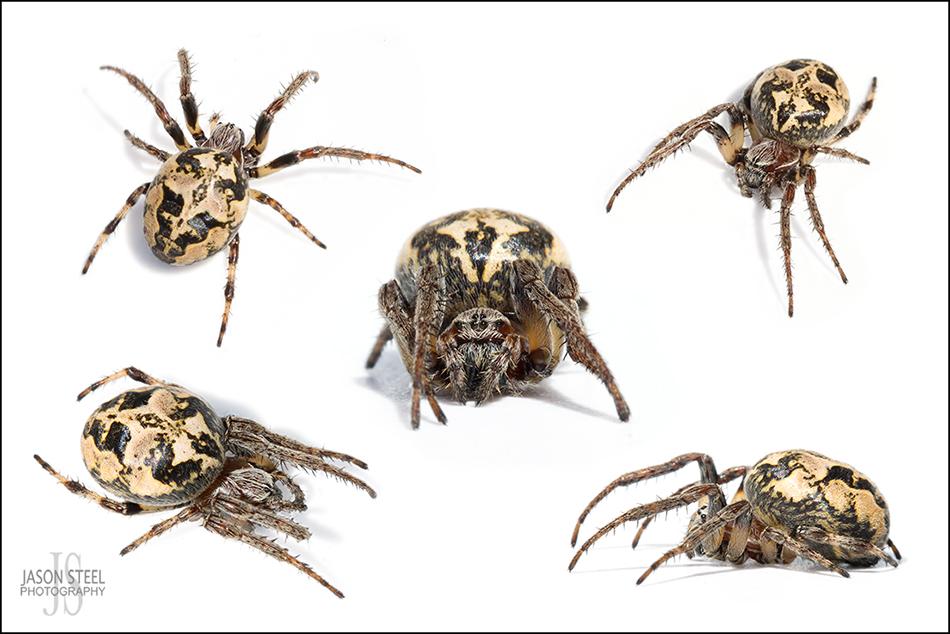
Adult female Furrow Orb-Weaver Spider - Larinioides cornutus
Furrow Orb-Weaver Spider - Larinioides cornutus
Usually found in damp places such as reeds and other waterside vegetation, as well as on bridges and posts. Females have a maximum body-length of 14mm with a 35mm leg-span. Males have a maximum body-length of 9mm with a 18mm leg-span. During mating peiods in Autumn and Spring, the males and females can be found living together. The large orb webs are usually empty during the daytime whilst the spider hides in a silken retreat nearby. Damaged webs are repaired at night.
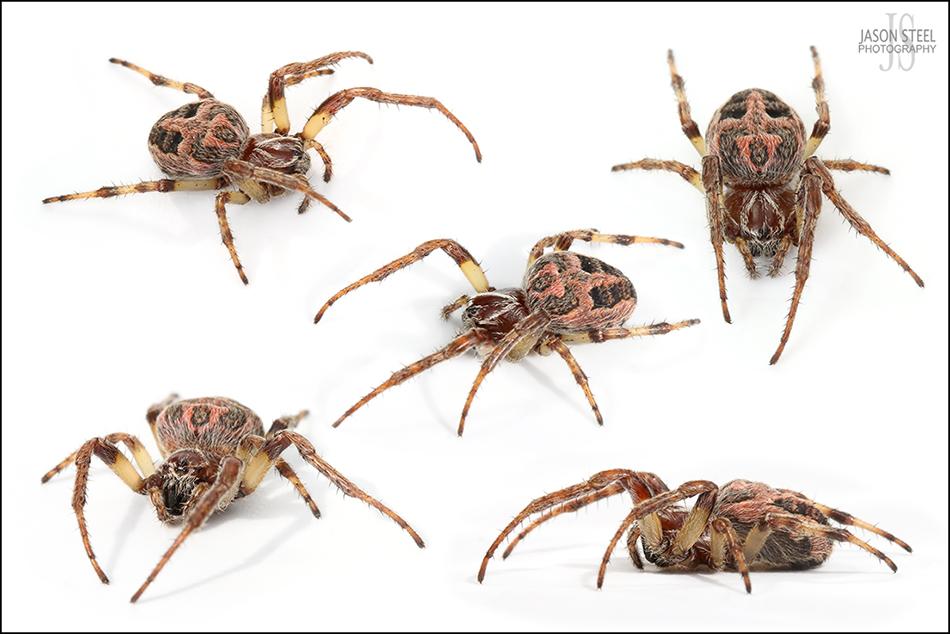
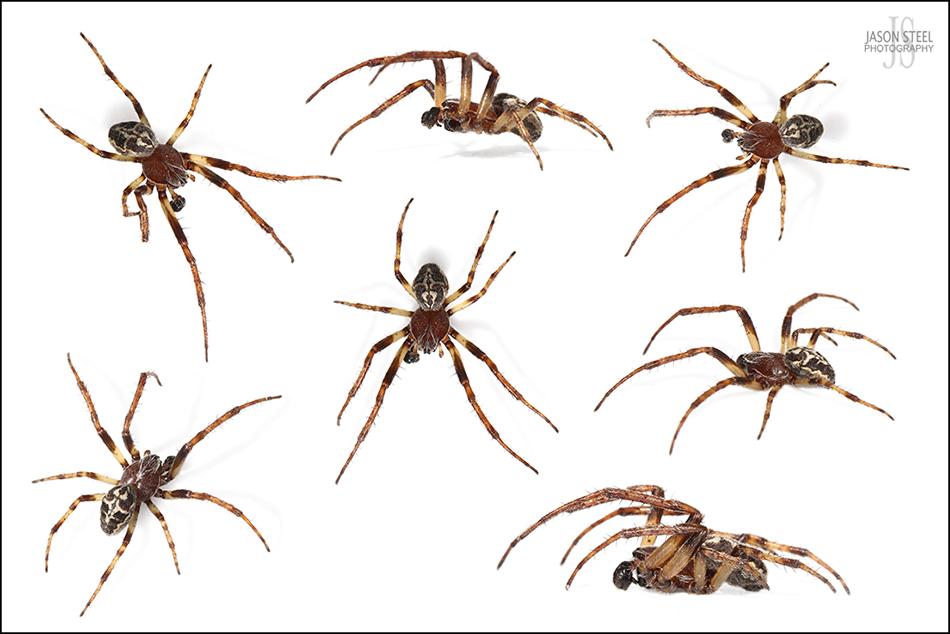
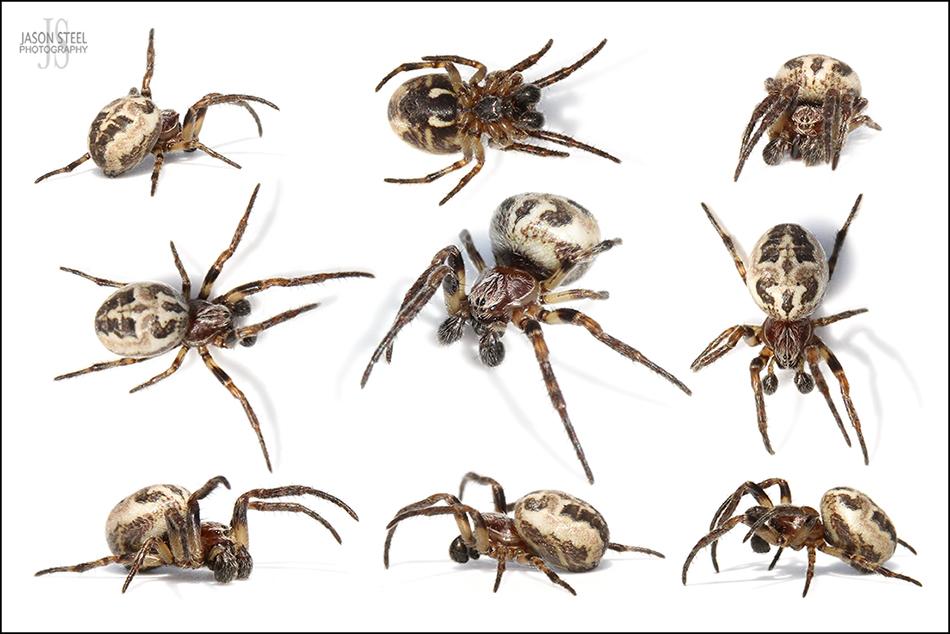
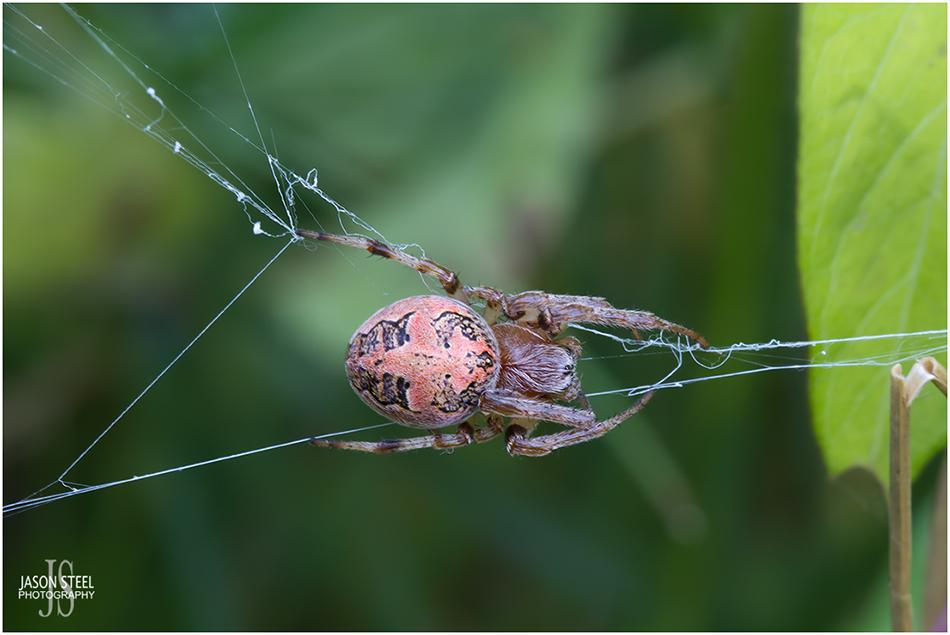
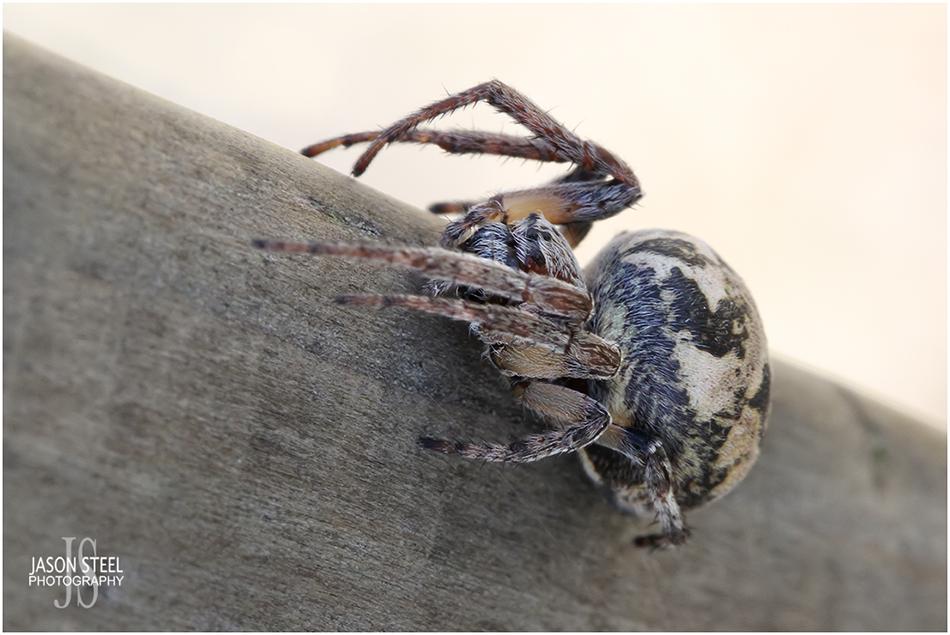
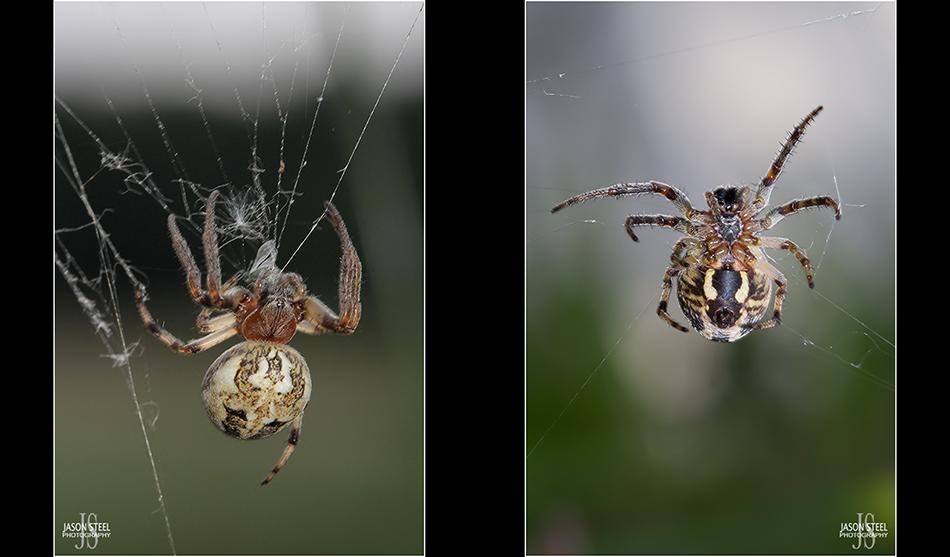
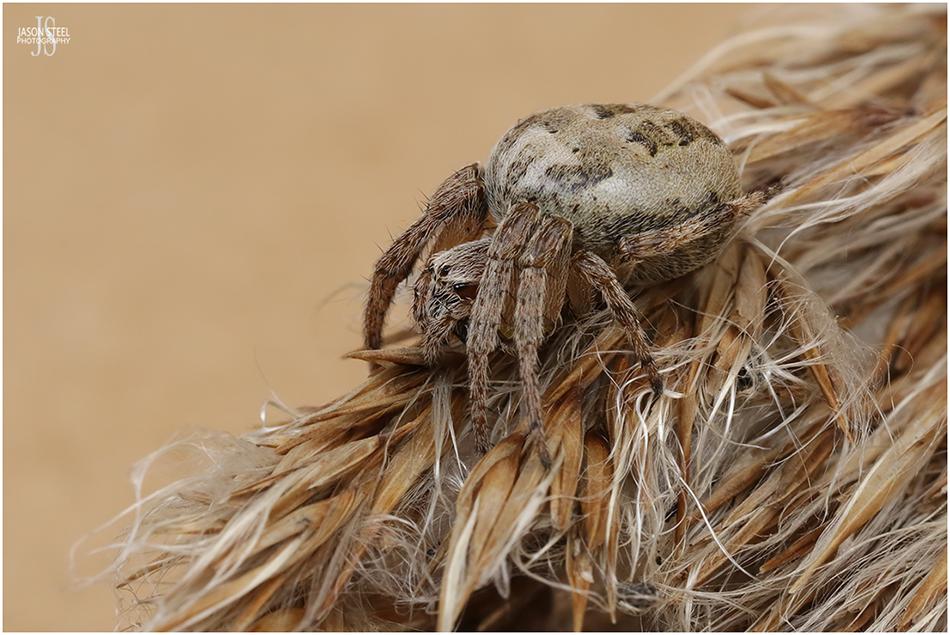
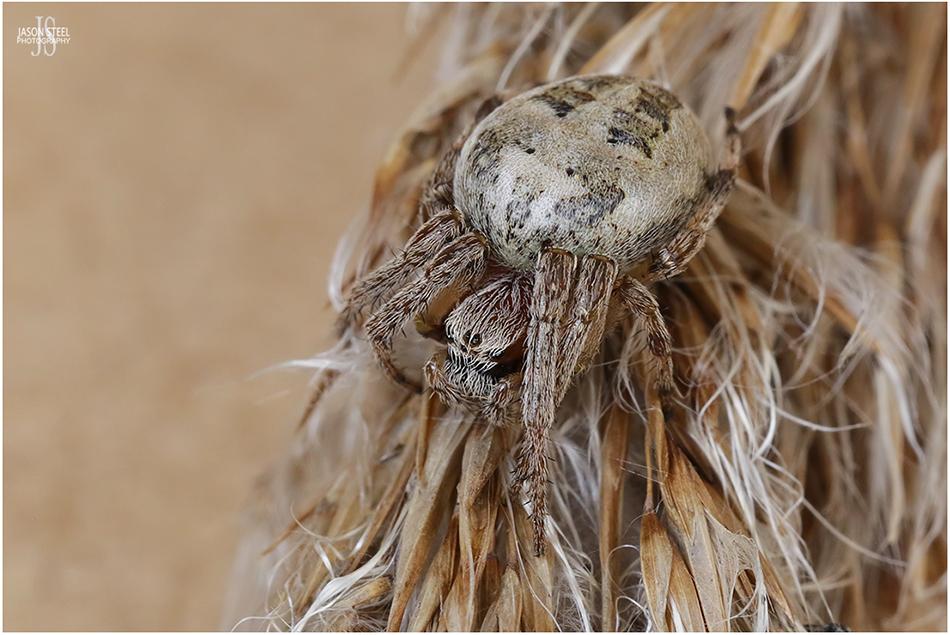
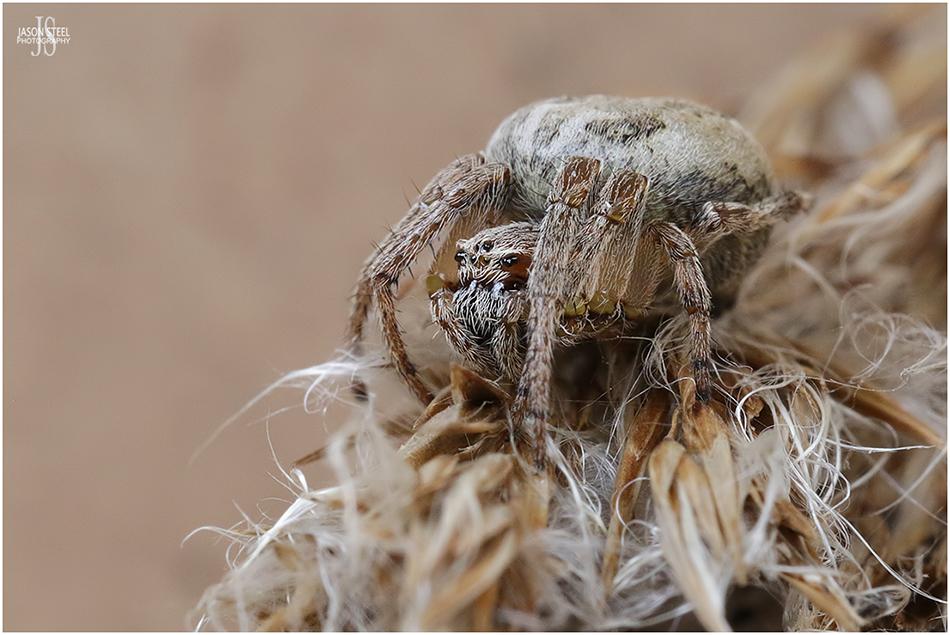
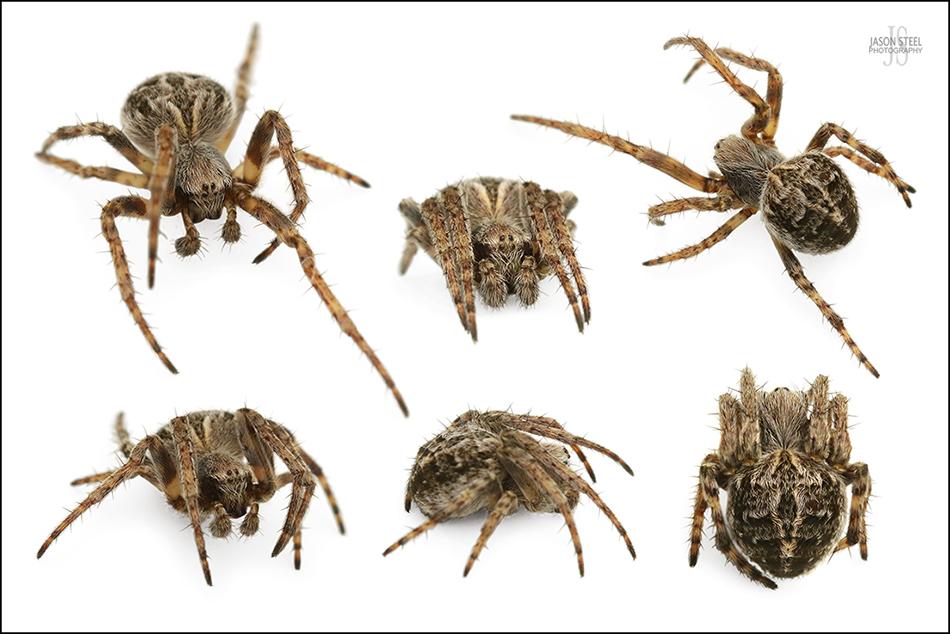
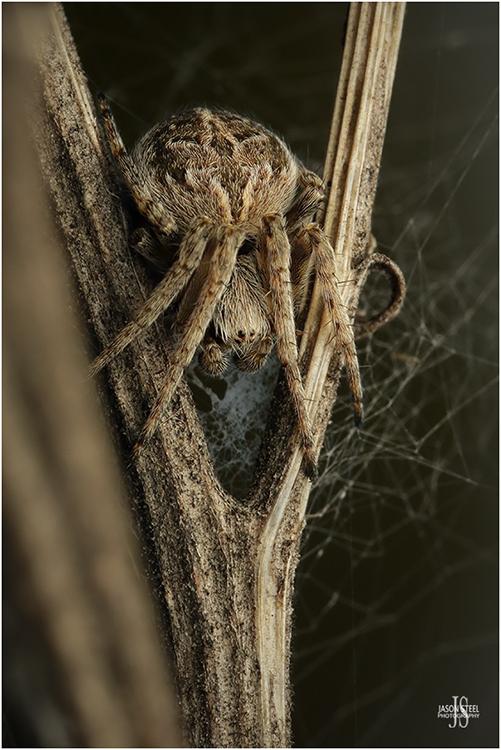
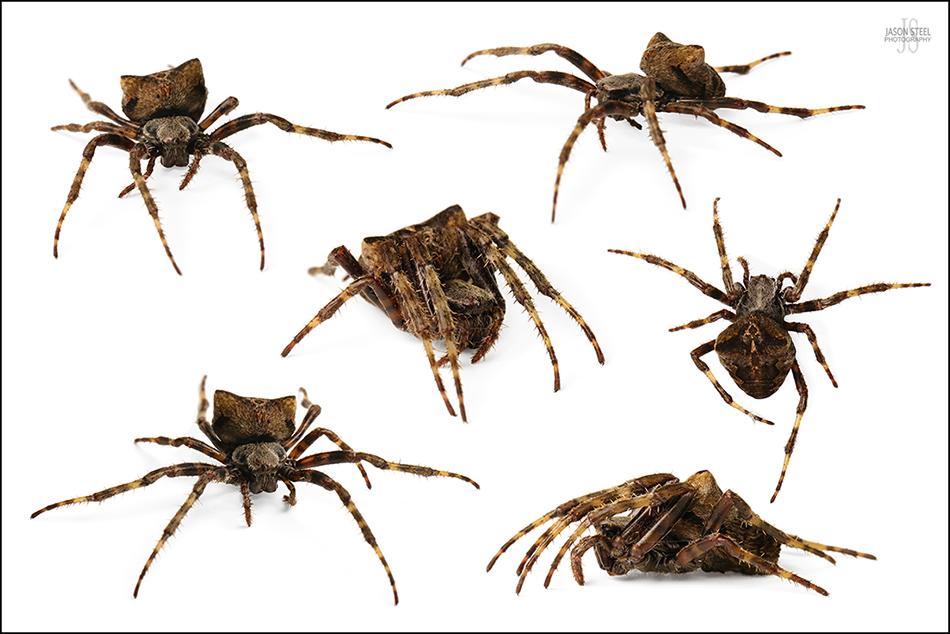
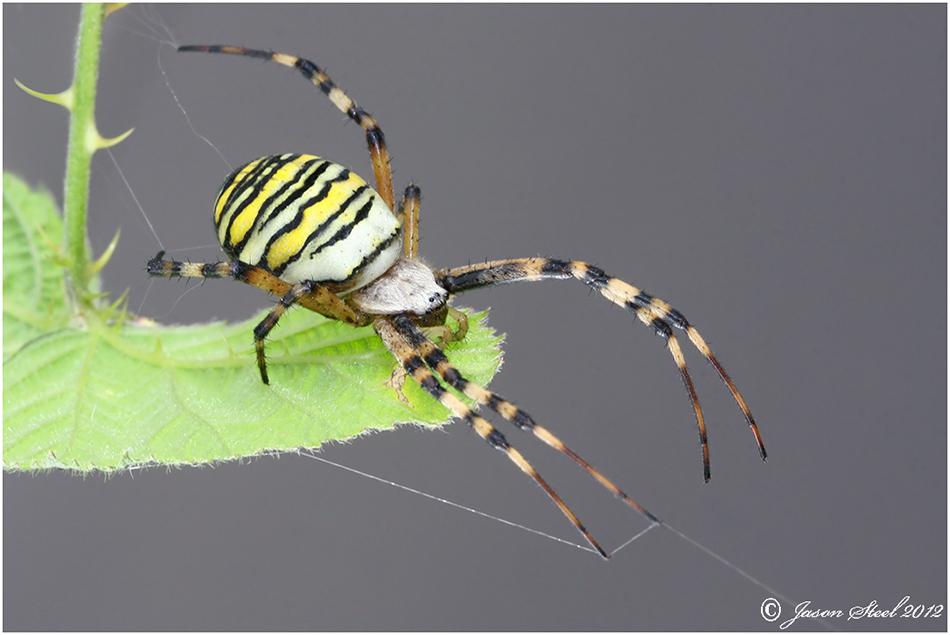
Wasp Spider (Argiope bruennichi)
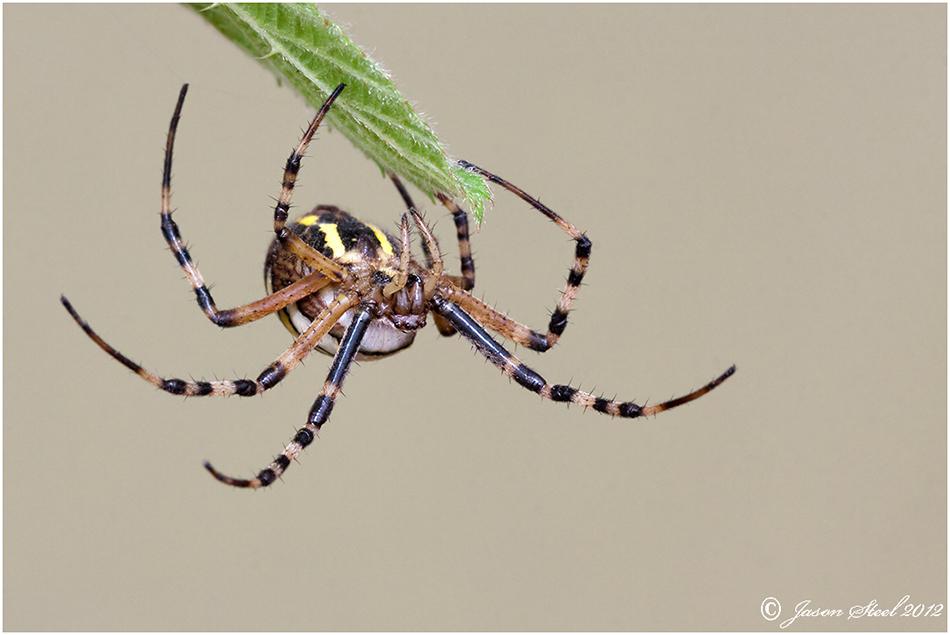
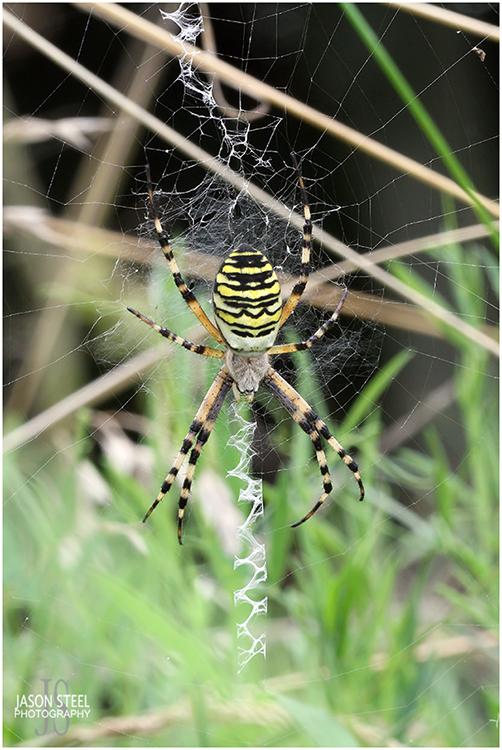
Argiope species of spider, including the Wasp Spider, display distinctive zig-zag patterns in the middle of their webs. These markings are known as stabilimenta, or stabilimentum plaural. No one is 100% sure of the purpose of these zig-zag patterns but one popular theory is that they may help to attract some species of insect prey to the web by reflecting ultraviolet light. It was originally believed that these stabilimenta were used for stabilising the webs, hence the name, but this idea has been disregarded by most people because these stabilimenta are often only loosely attached to the web and would do little to add any structural strengthening.
As of 2019 there are 88 different species in the Argiope genus around the world. In Cyprus they have both the Lobed Argiope, Argiope lobata, and the Banded Garden Spider, Argiope trifasciata. Argiope lobata are particularly impressive with their large size and abdominal lobes, or spines. In Southern USA and some South American countries they also have an Argiope species that exhibits these abdominal spines, the Silver Argiope, or Silver Garden Spider, Argiope argentata. As its name suggests the Silver Argiope typically exhibits the silver carapace / cephalothorax, as seen on most Argiope species, but it also has silver colouration to the front half of its abdomen as well. It is believed the silver colouration reflects UV light in the smae way as many flowers do, and may actually attract flying insects to the web of the spider.
Australia has two Argiope species, Argiope keyserlingi and Argiope aetherea, that are both known as St Andrew's Cross Spiders. Not only are these spiders frequently observed during the daytime in the middle of their webs, with legs held together in pairs and stretched out to form a "X" shape, but the stabilimentum is also built in the shape of a large white "X" too.
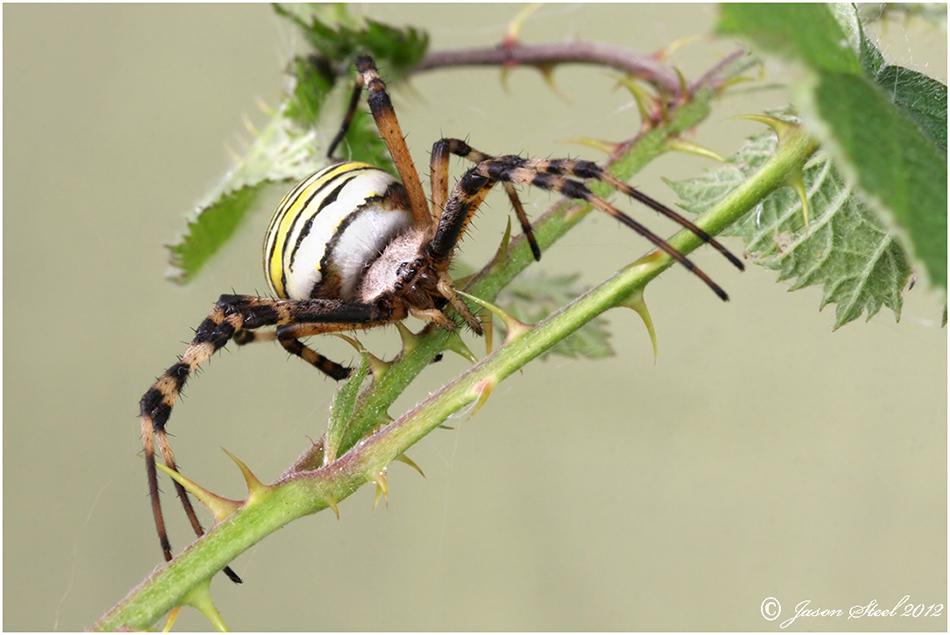
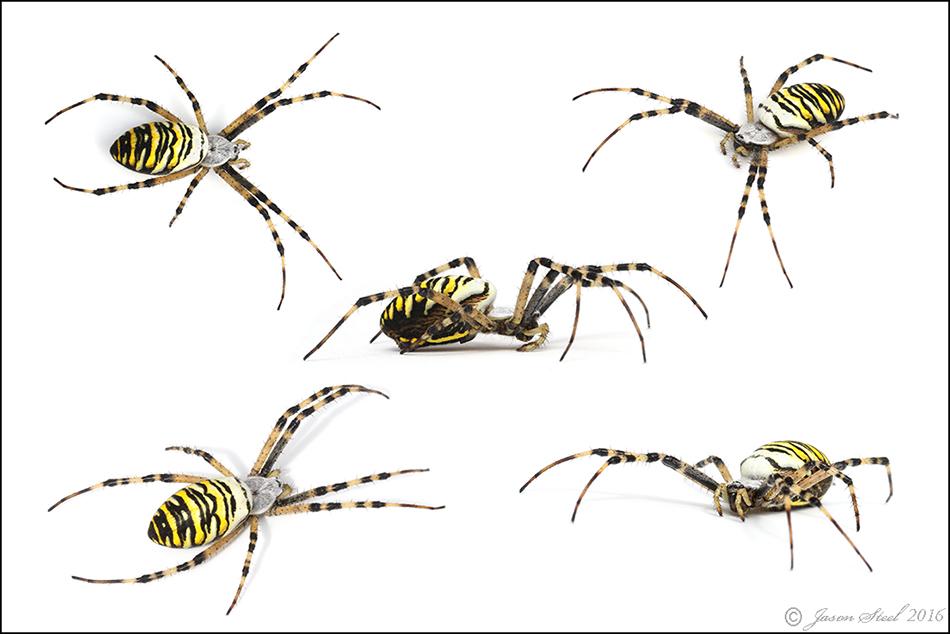

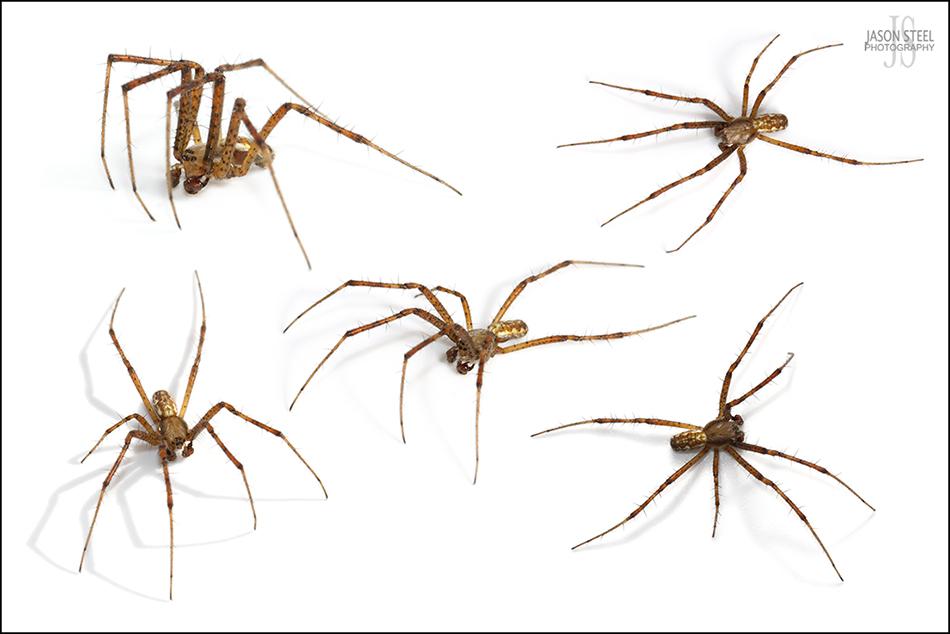
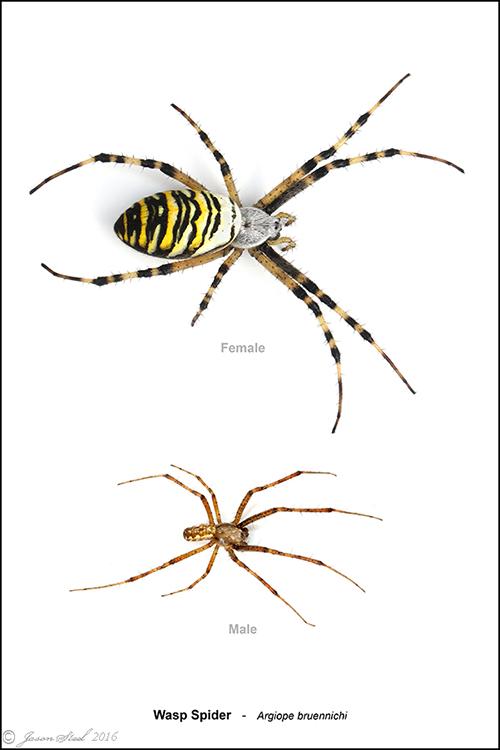
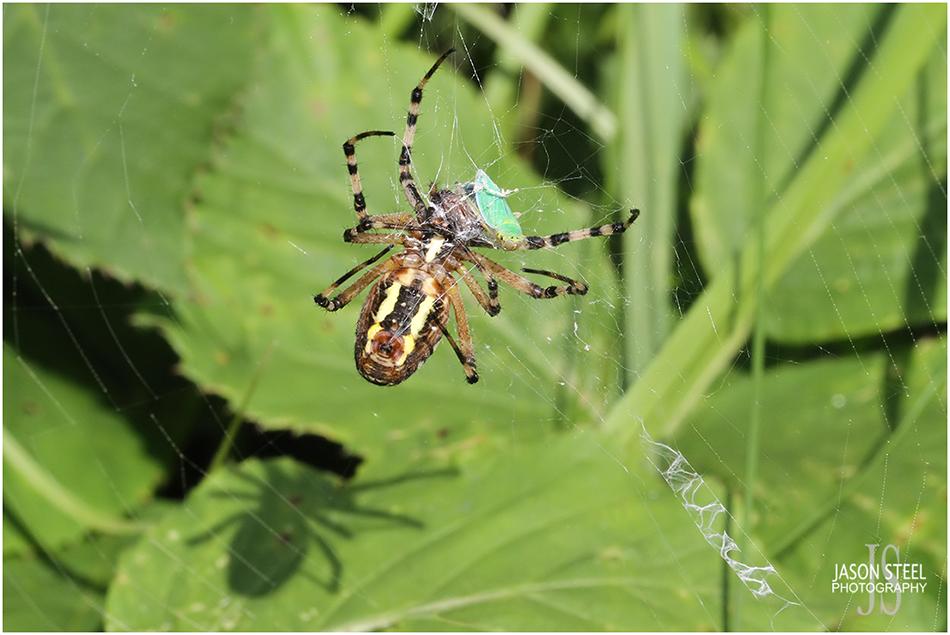
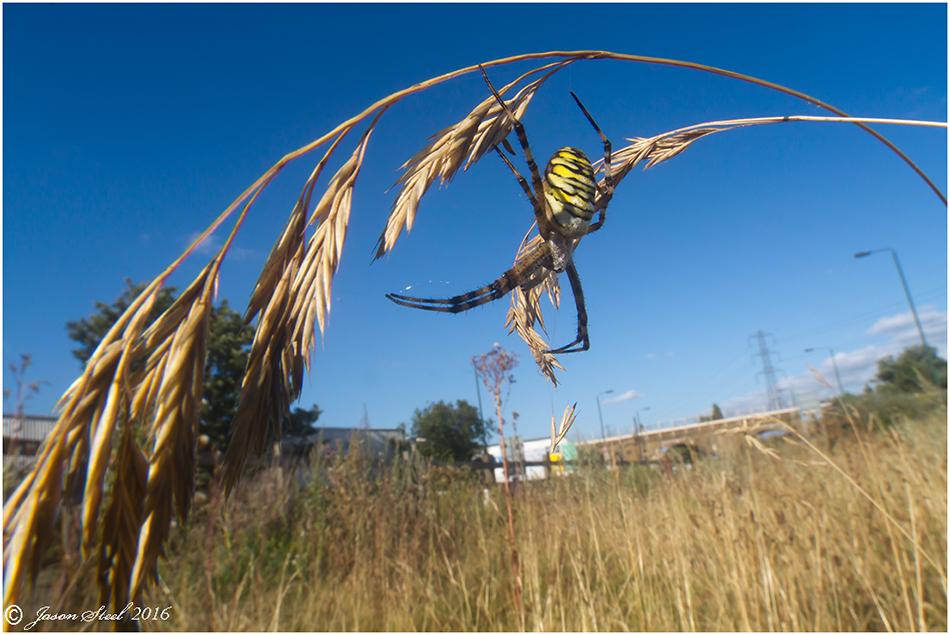
Wasp Spiders often display the same defensive strategy when approached. They are often witnessed dropping from their web completely and remaining completely motionless on the ground beneath the web in the hope that any would-be predator will not be able to find them.
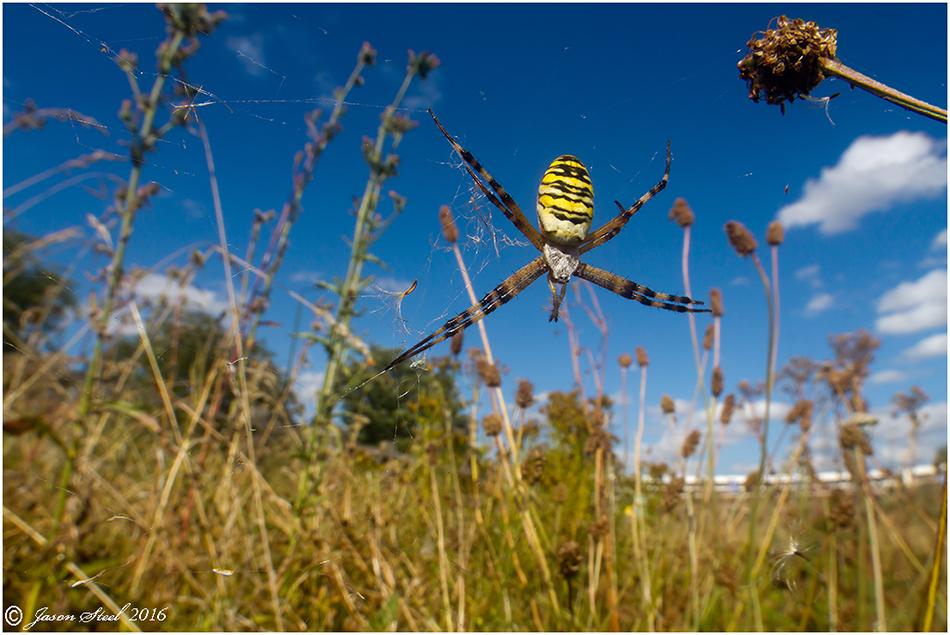
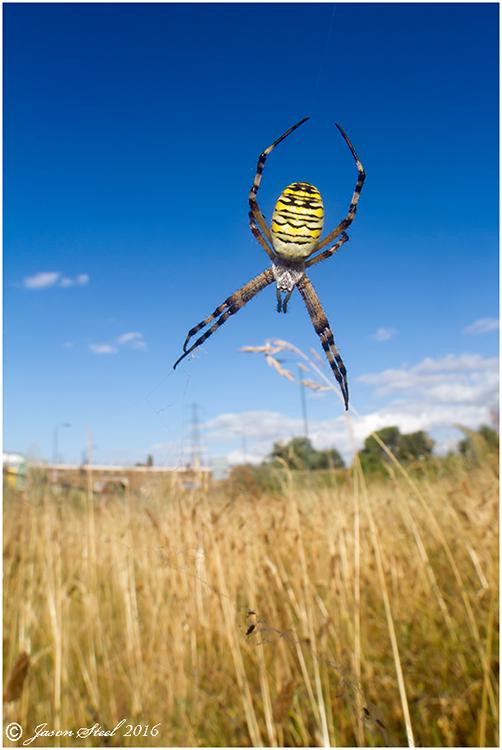
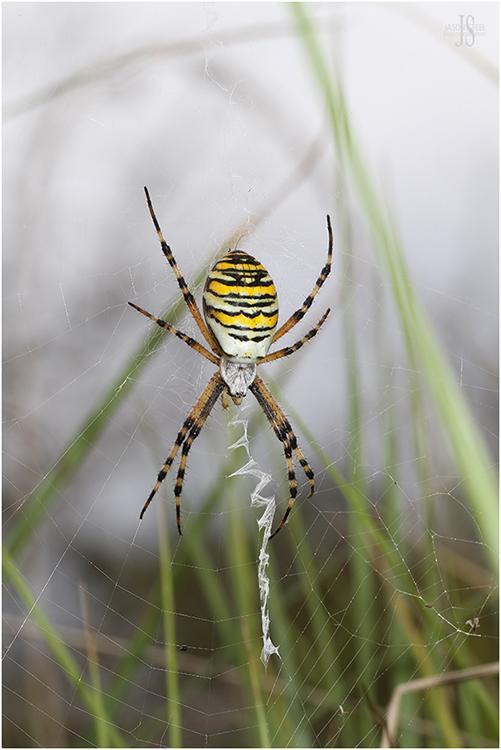
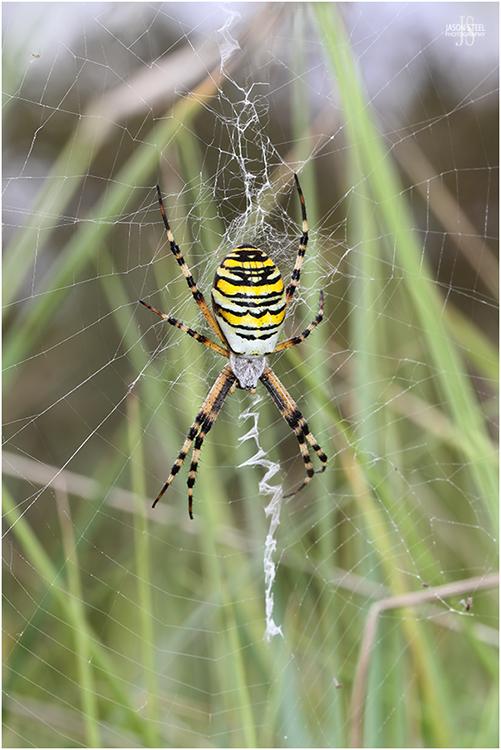
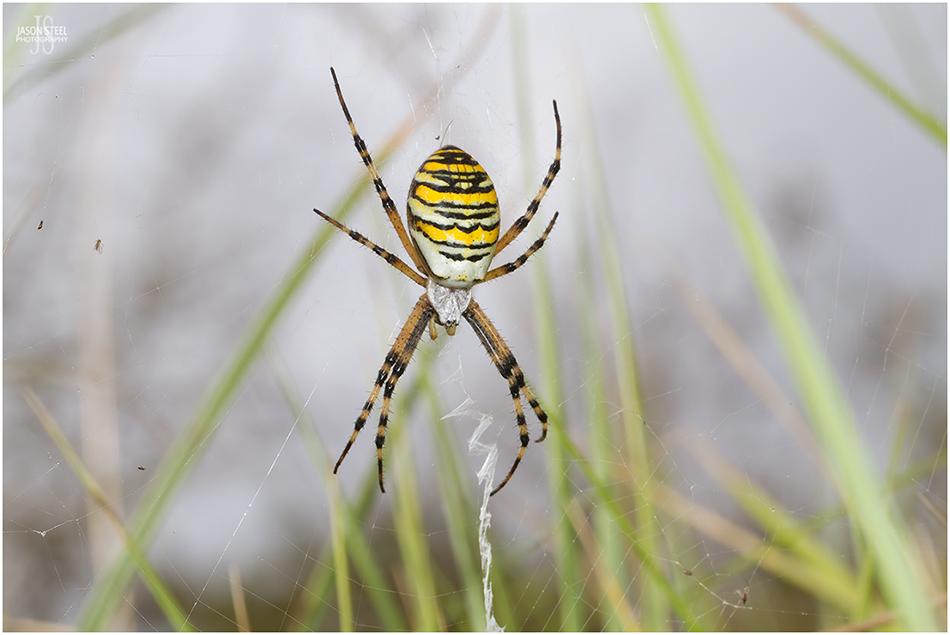
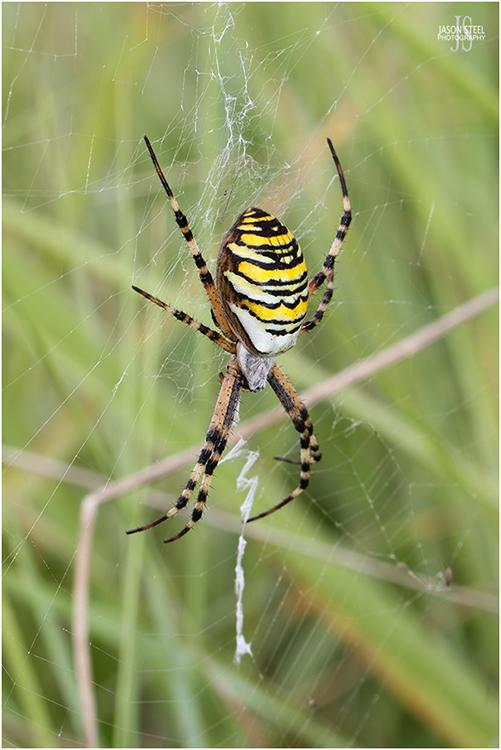
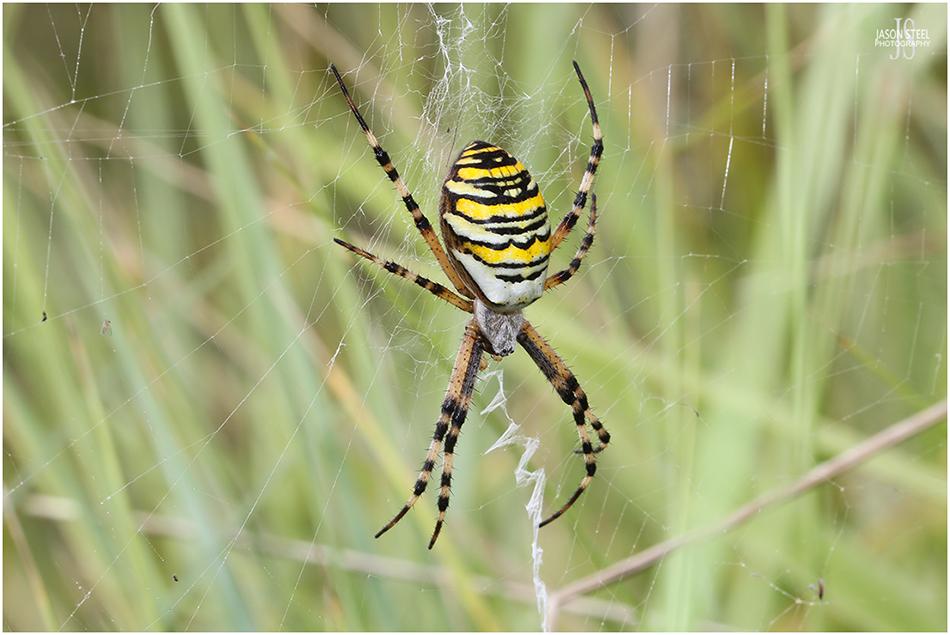
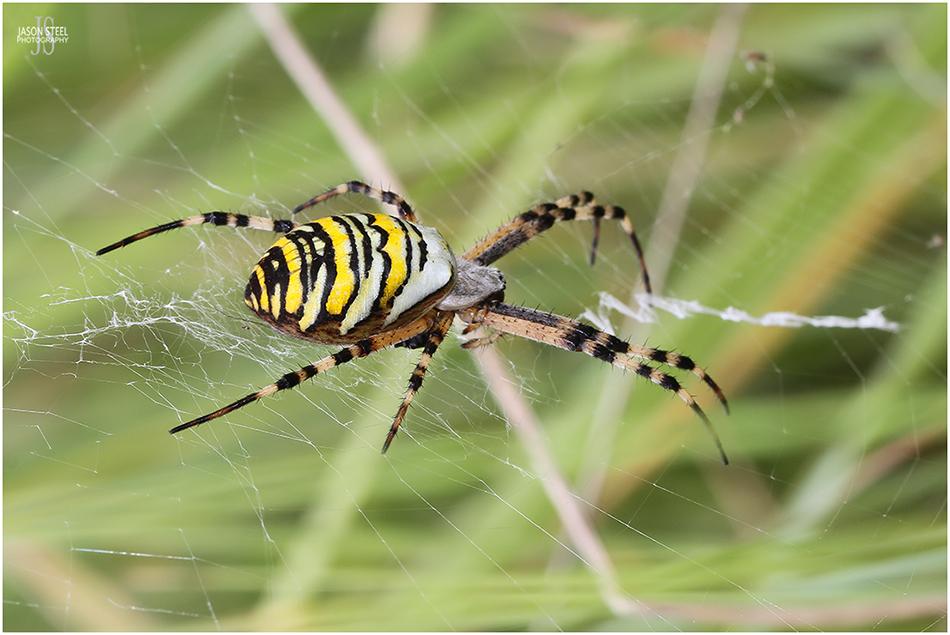

Wide-Jawed Orb Weaver Spiders - Tetragnatha Sp
Long / Wide-Jawed Orb Weaver Spiders (Tetragnatha Sp)
There are six Tetragnatha species of Wide-Jawed Orb Weaver species in the UK. The two most commonly encountered in the UK are Tetragnatha extensa & Tetragnatha montana. Wide-Jawed Orb Weavers have a body-length of 5-15mm and are commonly found around or near to water in low vegetation, but can also be found on occasion on bushes or trees. Colour can vary from pale yellow - light green - light brown. They have extremely long jaws (chelicerae), especially the males, with the fangs at the tips. When disturbed these spiders can adopt a defensive posture with their legs fully stretched out in-font and behind them, giving rise to the name "Stretch Spider". This enables them to hide behind thin vegetation. The orb-webs are loosely formed with an open centre and few radii. Wide-Jawed Orb Weavers are usually found between May and August in the UK with some still around in September. Identifying specific species can be very difficult without close inspection.
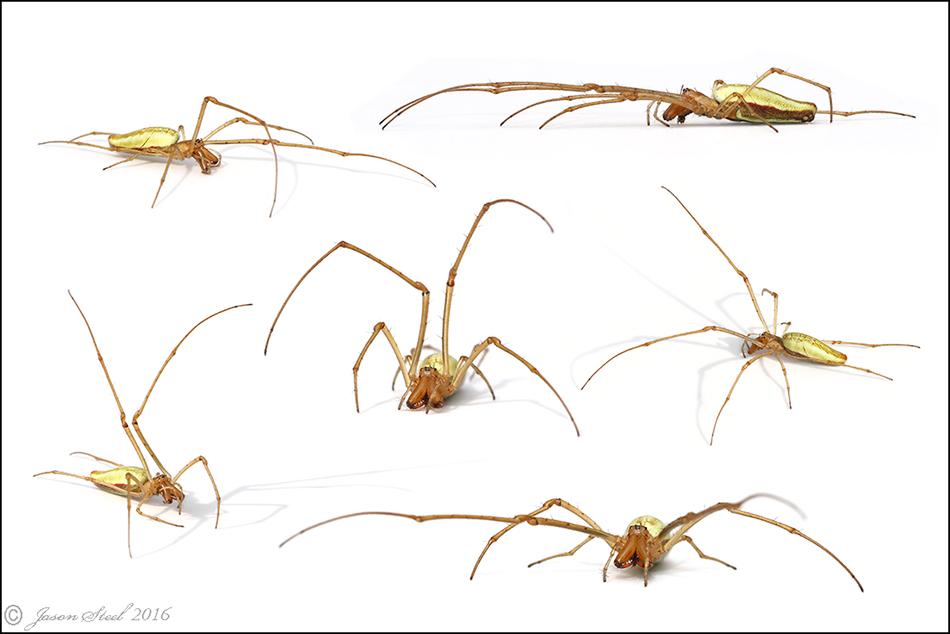
Female Long / Wide-Jawed Orb Weaver Spider - Tetragnatha extensa.
Common Stretch Spider (Tetragnatha extensa)
A common and widespread species found across the UK, Western Europe and the American continent. They commonly make their webs in grasses and other low vegetation, particularly besides fresh water. Females typically reach a body-length of 5-11mm , and the males reach 5-9mm. Adults of both sexes are usually seen from May to July, and sometimes well into autumn. The body colour varies from pale yellow to golden brown or green.
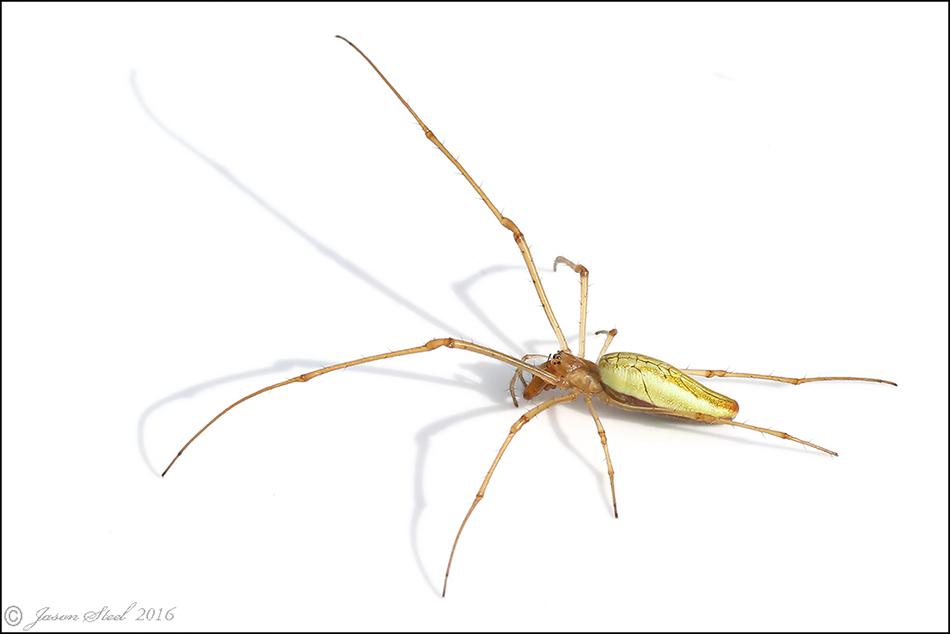
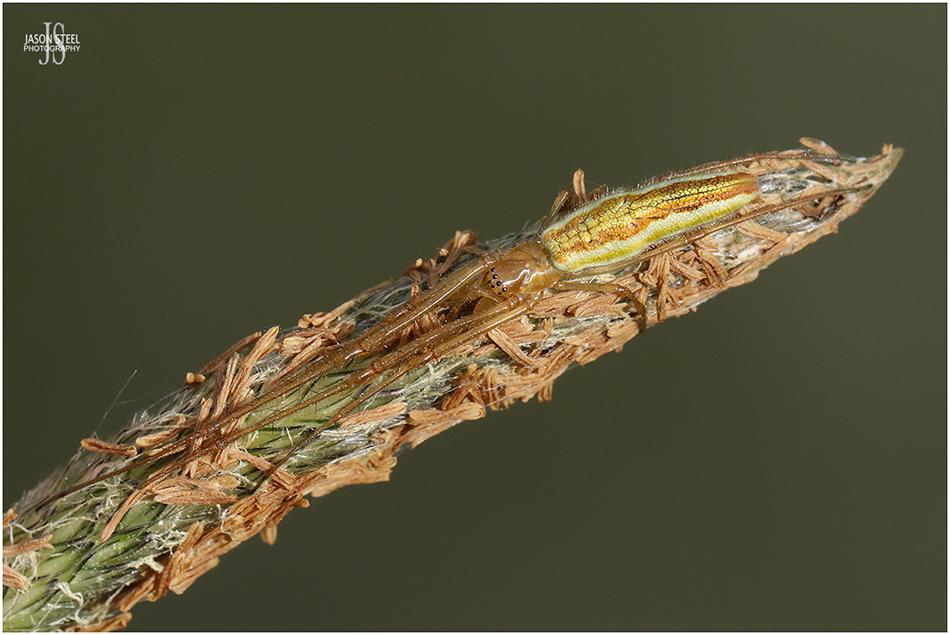
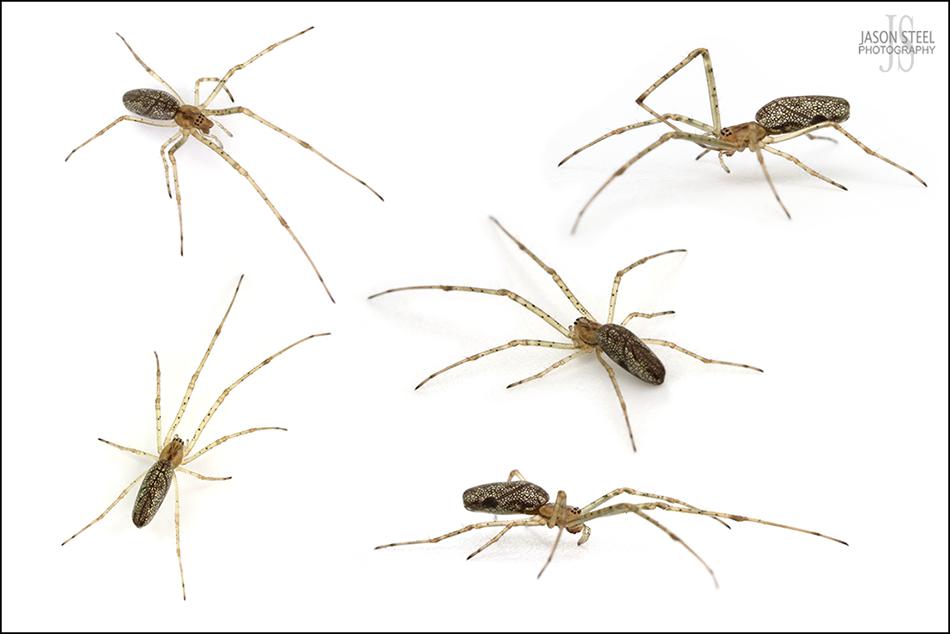
Female Shadow Stretch Spider - Tetragnatha montana.
Shadow Stretch Spider - (Tetragnatha montana)
Another common and widespread species found across the UK. They commonly make their webs in trees, bushes or low vegetation, particularly besides fresh water. Although this species is not as closely associated with water and wetlnds habitats as Tetragnatha extensa. Females typically reach a body-length of 7-13mm , and the males reach 6-8mm. Adults of both sexes are usually seen from May to July, and sometimes well into autumn. As its name suggests the Shadow Stretch Spider can often be found in shaded areas.
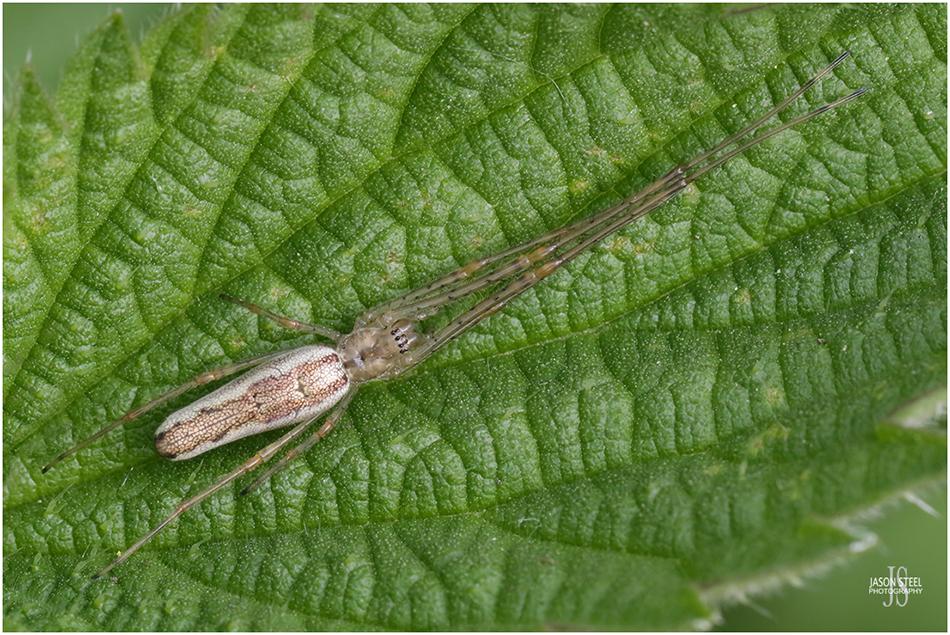
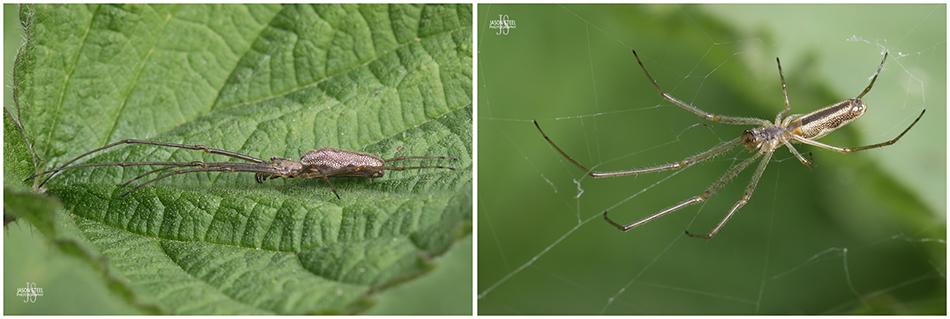
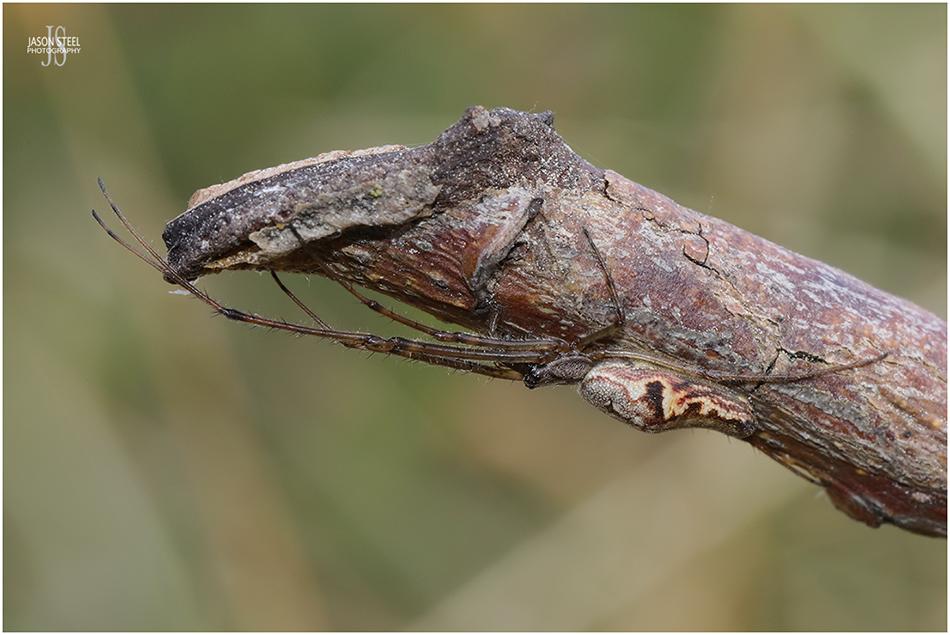
12mm Dark Stretch Spider, Tetragnatha nigrita found on the low branches of a young Goat Willow Tree, at Swanscombe Marshes, Kent, 3rd July 2022.
Dark Stretch Spider - (Tetragnatha nigrita)
The Dark Stretch Spider is typically much darker than other Tetragnathidae, but can often be found in similar habitats. Whilst their habitats can vary they are most commonly encountered in their orb-web, on the low branches of young trees, bushes or low vegetation, often, but not always in areas close to fresh water. Adults can be found from May to August, but regularly seen in June & July. Females usually reach a body-length of 7-11mm, and the males reach 6-8mm. This species can be found in the southern half of England, where it is classed as widespread, but locally uncommon.
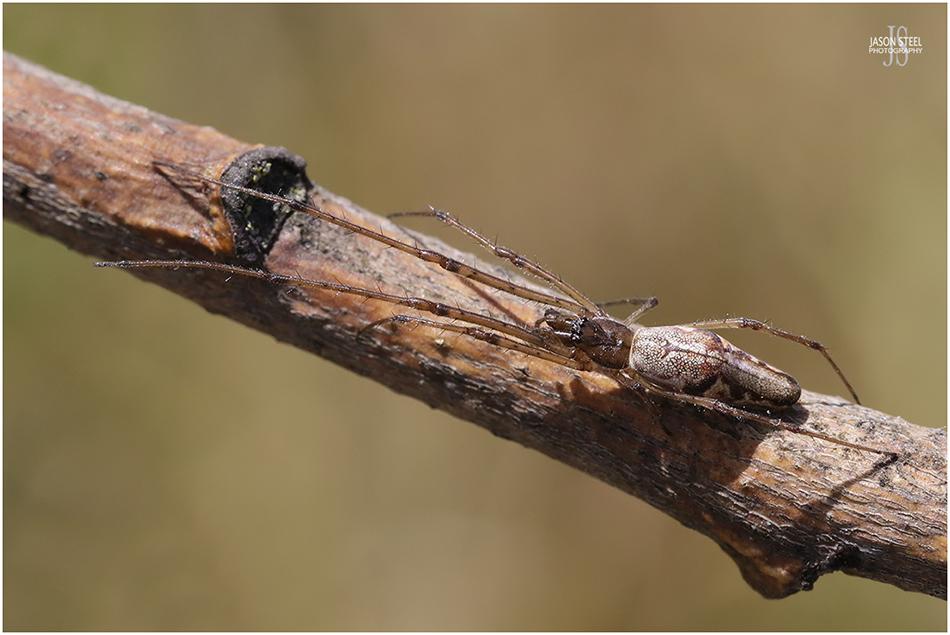
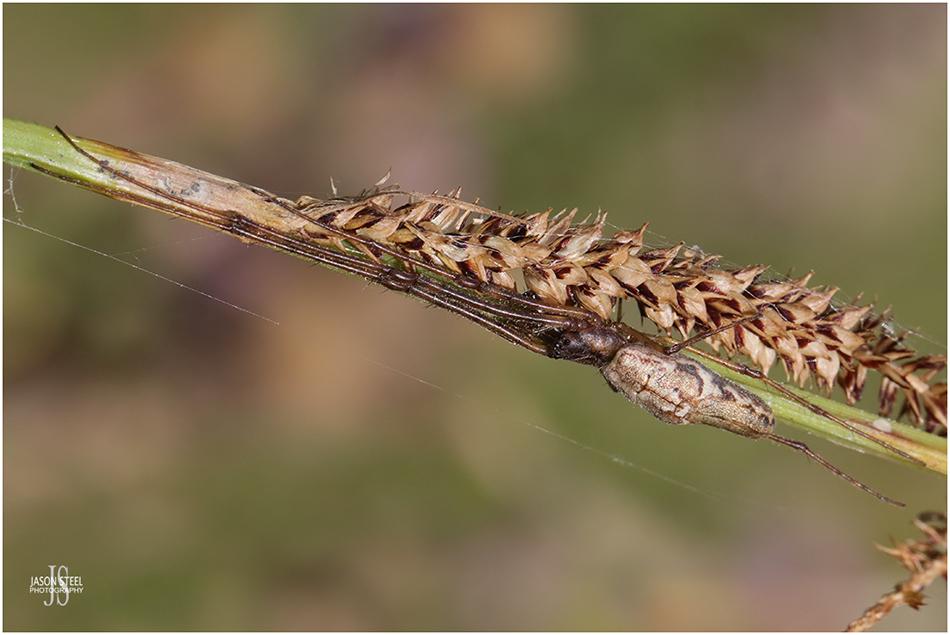
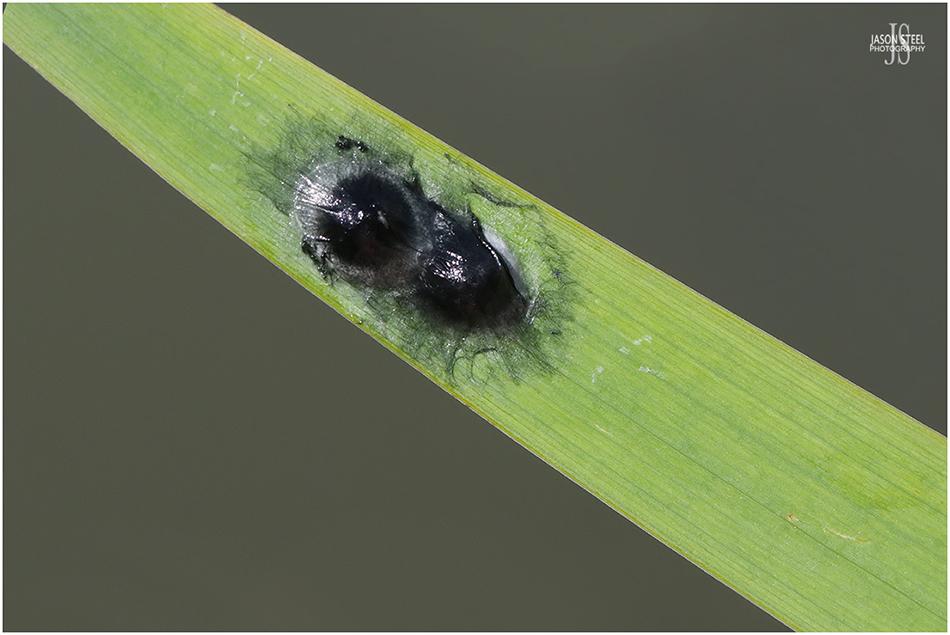
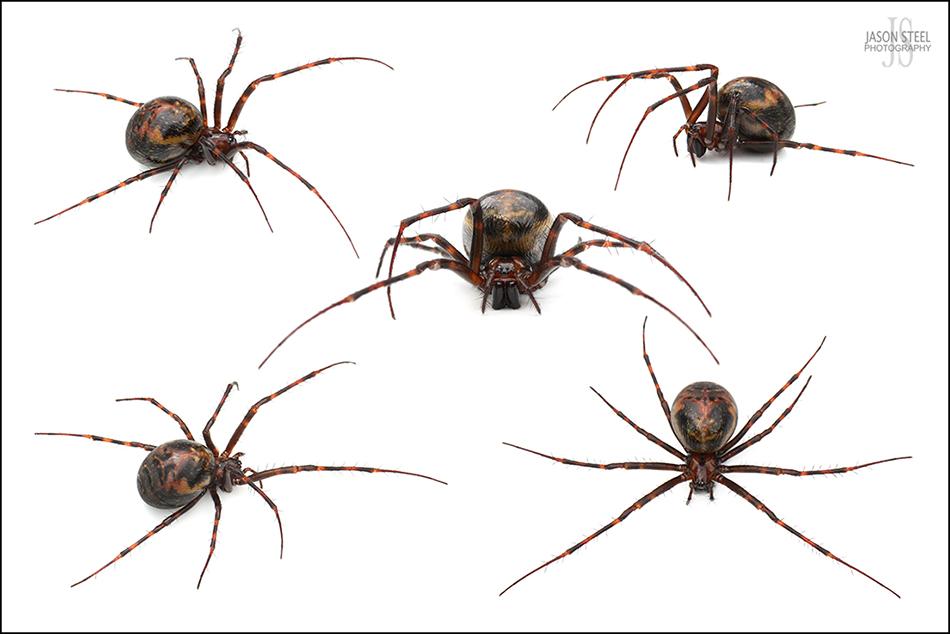
Large female European Cave Spider (Meta menardi), found in Kent beneath a manhole cover for a residential sewer outlet.
European Cave Spider (Meta menardi)
